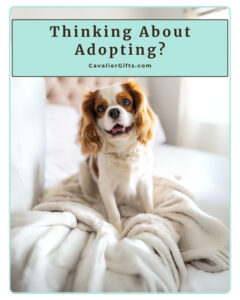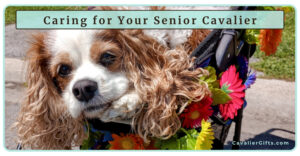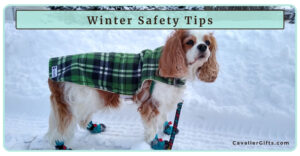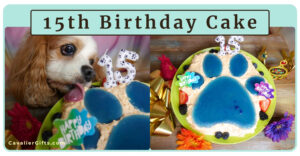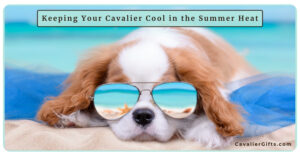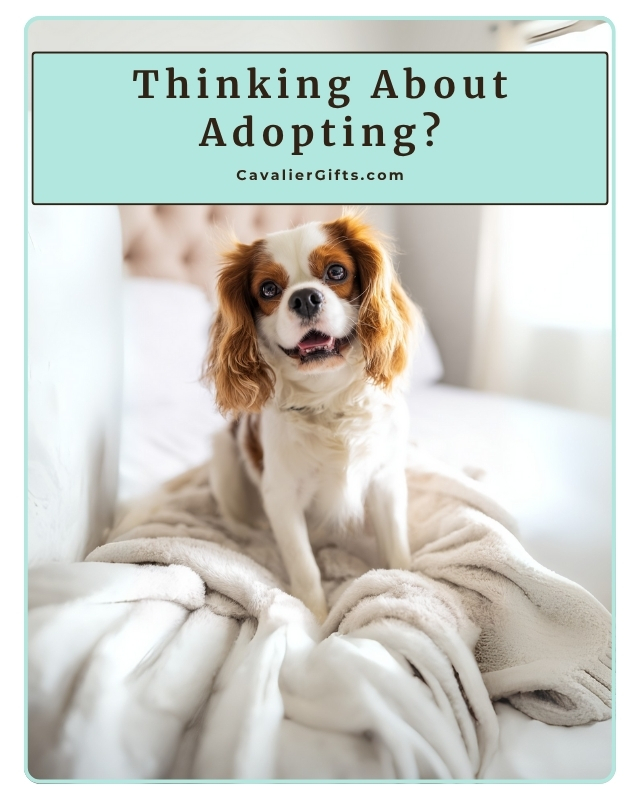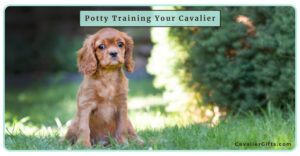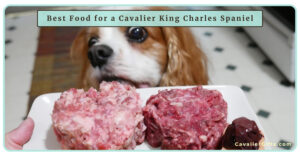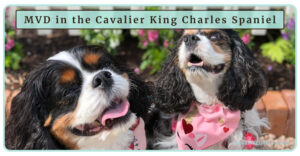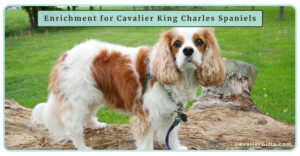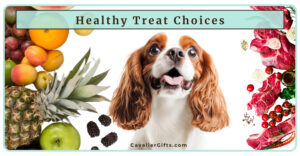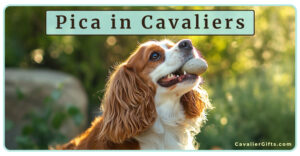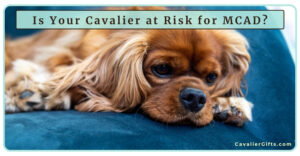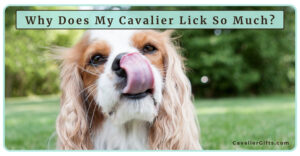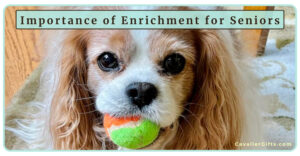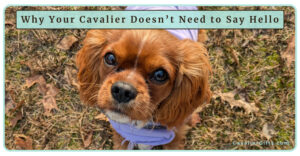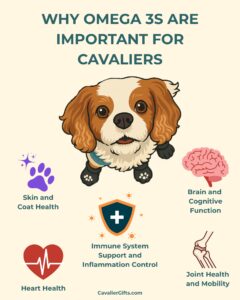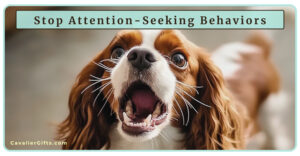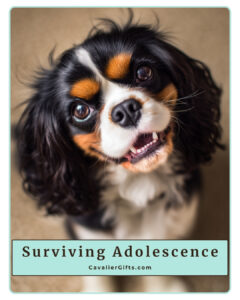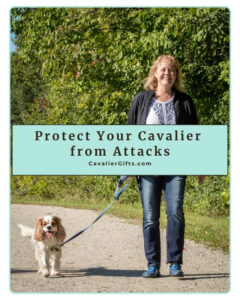Category: Care
Essential Cavalier King Charles Spaniel Care: Grooming, Ears & More! Master the basics of keeping your Cavalier healthy with expert tips on grooming, ear cleaning, nail trimming, & essential hygiene routines.
Thank you for visiting our Cavalier King Charles Spaniel blog. While I’m getting this blog set up, please enjoy the Cavalier King Charles Spaniel videos I’ve created below. Don’t forget to join our supportive and friendly Cavalier Training and Care Facebook group.

Natural Flea and Tick Prevention for Cavalier King Charles Spaniels (Early access for our Patreon community)
Gentle, Safe, and Effective for Our Sensitive Cavaliers
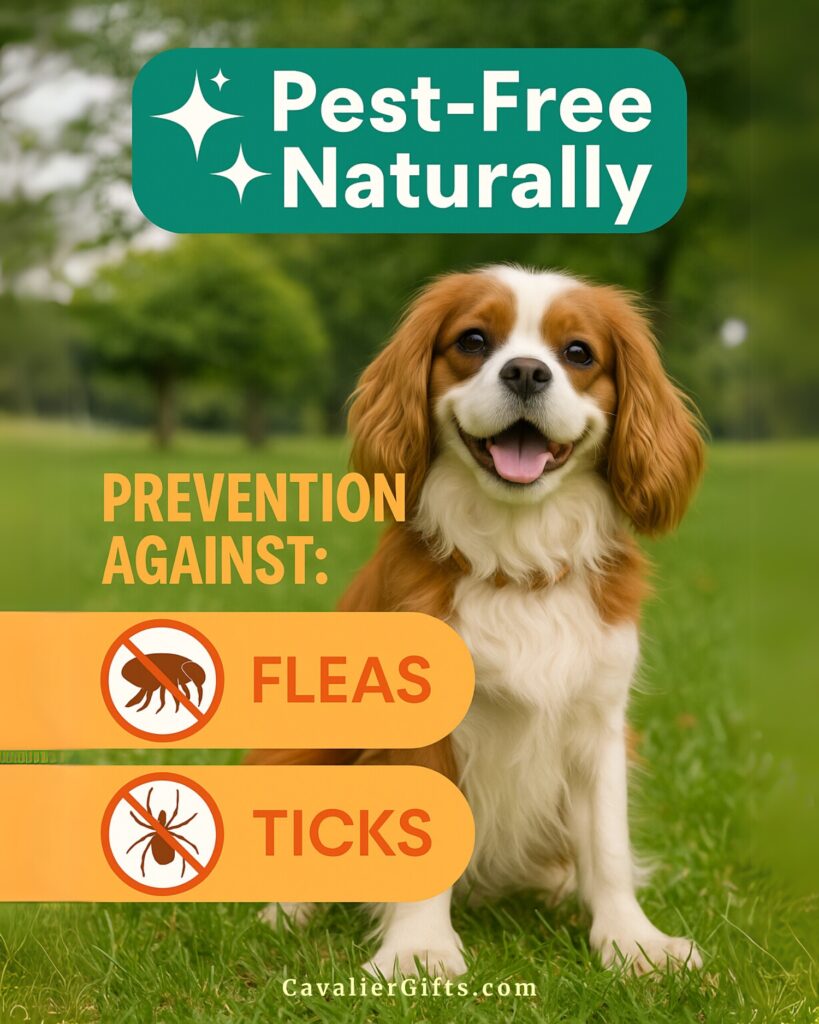

Fleas and ticks. Just hearing those words makes me itch. But as a natural Cavalier Mom, I’ve always been cautious about what I put on or in my dogs, especially with delicate and sensitive breeds like Cavalier King Charles Spaniels. These little sweet hearts often have sensitive skin, luxurious coats, and sometimes underlying conditions like Chiari malformation or syringomyelia, which can make them more vulnerable to adverse reactions.
I’ve been on this natural journey for years, first with Dexter and now with Stewart. Along the way, I’ve learned that staying chemical-free when it comes to flea and tick care is absolutely possible, it just takes a little planning and a lot of label reading.
This is the natural flea and tick routine I’ve found works best for my Cavaliers.
Why I Choose a Natural Approach for My Cavalier King Charles Spaniels
Conventional flea and tick treatments may offer quick results, but they also come with serious risks. Side effects can range from skin irritation, itching, and digestive upset to more concerning issues like tremors, seizures, and in some cases even organ damage. These are not small concerns.
For a breed like the Cavalier King Charles Spaniel, those risks are even more concerning. Cavaliers are already prone to neurological conditions like Chiari malformation, seizures, tremors, and episodic falling syndrome. I’m especially cautious about using anything that lists seizures or neurological side effects as possible outcomes. It just doesn’t make sense to use a treatment that could trigger the very issues this breed is already vulnerable to.
Choosing a natural approach isn’t about trying to be perfect. For me, it’s about reducing chemical exposure wherever I can and building a thoughtful, layered prevention plan that supports overall health instead of relying on a single product to do it all.


My Natural Flea and Tick Prevention Plan for My Cavalier King Charles Spaniel
1. Regular Grooming and Bathing-I bathe Stewart every three to four weeks using a safe, gentle dog shampoo made without synthetic preservatives, artificial fragrances, or harsh surfactants. I’ve been using 4-Legger’s USDA-certified organic formulas for years because I trust their ingredient panel and transparency. They have a variety of formulas that help deter ticks and fleas.
Bathing regularly doesn’t just clean your Cavalier. It helps interrupt the flea life cycle. A good soak and lather can wash away flea eggs, dirt, and debris that might attract pests. When I use a shampoo that includes properly diluted essential oils known to repel fleas and ticks, it gives Stewart an extra layer of protection even after his bath is done.
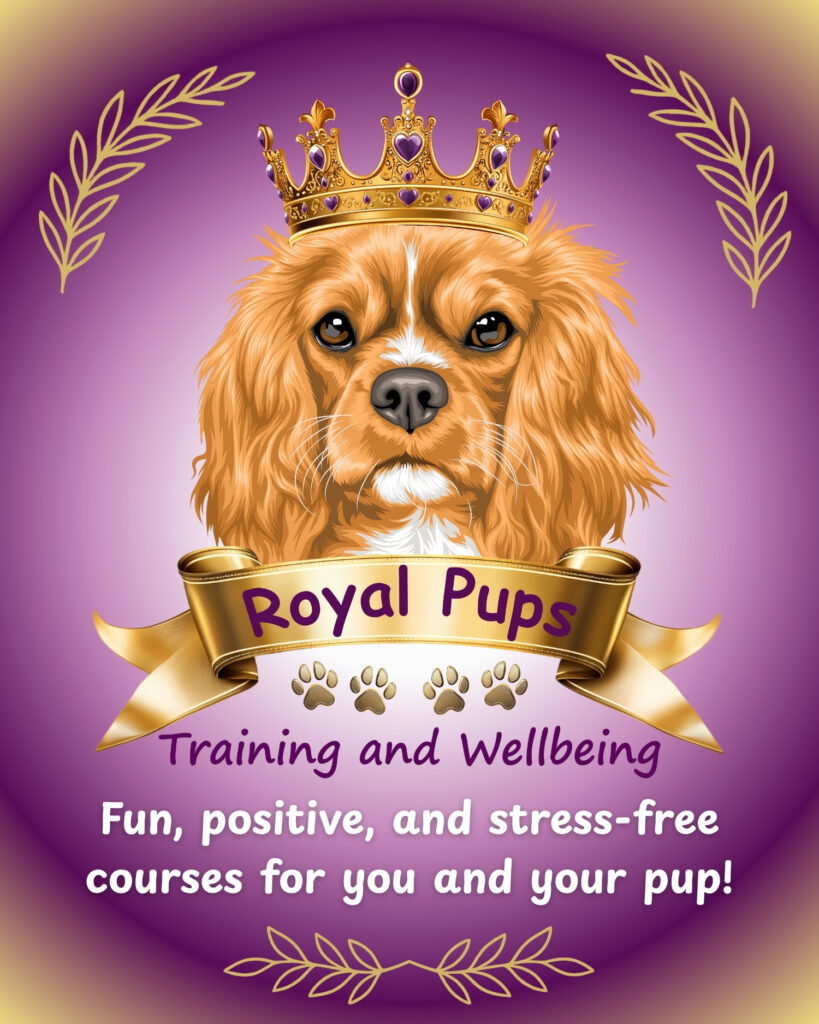

2. Natural Tick and Flea Sprays for Daily Protection-Before every walk, I spray Stewart with a natural flea and tick repellent. I pay close attention to his legs, chest, tail, and belly, basically anywhere that might brush up against grass, shrubs, or wooded areas. These sprays are one of our most important layers of protection, and I use them daily during warm weather or anytime we’re heading into a high-risk area.
Over the years, I’ve rotated between trusted store-bought options and homemade recipes using properly diluted dog-safe essential oils. I always avoid sprays with synthetic preservatives or ingredients that could irritate a dog’s skin.
When I make my own, I tailor the recipe to the season, the environment, and even the behavior of my dog. Dexter, for example, used to try to catch bees, so I avoided blends with oils like rose geranium that might attract them. The key with any natural tick and flea spray is to apply it each time your Cavalier goes outside. These blends are not designed to last for hours at a time, and a quick re-spritz before each outing is what really makes the difference. I keep a bottle near the door so it becomes part of our daily walking routine.
DIY Natural Flea and Tick Spray for Dogs
This is one of my favorite natural sprays to help keep fleas and ticks at bay, without resorting to harsh chemical treatments. It’s simple to make, and you can use it on both your dog and yourself before heading outside.
What You’ll Need:
- 3 ounces distilled water
- 1/4 ounce vodka or grain alcohol (helps disperse oils evenly)
- 1/4 teaspoon vegetable glycerin (moisturizing and helps blend)
Essential Oils:
- 4 drops Cedarwood– repels fleas and ticks while being gentle on skin
- 4 drops Geranium– especially helpful against ticks
- 3 drops Lavender– calming and gently repels insects
- 1 drop Citronella– useful for deterring mosquitoes, fleas, and ticks
- 1 drop Peppermint– offers cooling relief and additional repellent support


Grab my free Natural Flea and Tick Prevention Guide plus a bonus page on creating a dog-safe garden to help keep pests away naturally. Click to download your free copy!
How to Make It: Add all the ingredients to a 4-ounce (or larger) amber or cobalt blue glass spray bottle. Shake gently to combine.
How to Use It: Before walks or time outside, shake well and lightly mist your dog’s legs, belly, tail, and along the back. Always avoid spraying near the face and eyes. For areas like the ears, chest, or neck, spray a small amount into your hands first, then gently rub it into your dog’s fur. This helps you apply it more precisely and makes sure it reaches the coat and skin. Always apply when your dog is dry for best results.
Storage Tip: Store your spray in a cool, dark place and an amber or cobalt glass bottle helps protect the essential oils from light exposure, which can cause them to break down over time. Shake before each use to keep the oils properly dispersed.


Simple DIY Natural Flea and Tick Spray for Dogs
When I first started making Dexter’s flea and tick sprays, I kept things really simple. I used just distilled water and a few carefully chosen essential oils. Using just distilled water and essential oils is a great option if you plan to make small batches and use them up fairly quickly. It is easy, gentle, and perfect for Cavalier parents who want something simple. You will still need to shake the bottle well before each use, just like with any natural spray.
If you want your spray to blend a little more evenly and stay fresher a little longer, using the above recipe with the grain alcohol and vegetable glycerin can help. Alcohol acts as a natural preservative and helps the oils disperse a little better through the water. Glycerin can also add some moisture to the coat and skin.
Both options are good, it really depends on what fits best with your dog’s needs and your routine. If you are going through the spray quickly, distilled water and oils work just fine. If you want a little more staying power and an extra moisturizing boost, the version with alcohol and glycerin might be a better fit.
You can also check out four of Dexter’s natural flea and tick spray recipes on my Raising Your Pets Naturally blog.
Watch now and don’t forget to subscribe to @RaisingYourPetsNaturally YouTube for more!
Why Different Natural Tick and Flea Sprays Work for Different Dogs
One thing I learned through experience and from chatting with other natural pet parents is that not every spray works the same way for every dog. Some ticks are more common in certain regions and are repelled by specific essential oils. That’s why I rotate between formulas and stay flexible with what I use. If something stops working, I adjust. It’s not failure, it’s just part of the process.
3. Apple Cider Vinegar for Flea and Tick Support-Raw, unfiltered apple cider vinegar (ACV) is another natural tool I like to keep on hand as part of a layered approach to flea and tick prevention. While it won’t kill fleas or ticks, it can help make your dog less appealing to them.
You can make a simple spray by mixing equal parts raw ACV and distilled water in a spray bottle and lightly misting your dog’s legs and belly. Just be sure to avoid the face, and only use it on healthy, unbroken skin. If your dog has any skin sensitivities or open spots, it’s best to skip ACV topically.
You can also add a small amount of ACV to your Cavalier’s food or water. Not all dogs tolerate vinegar well, especially those with sensitive stomachs or urinary issues. It’s also important if you add it to your Cavalier’s water, they also have non-altered fresh water available.


4. Amber Collars for Natural Flea and Tick Repellent Repellant-Another layer is a raw Baltic amber collar. These collars are made from unpolished amber resin that naturally releases aromatic compounds when warmed by your dog’s body. These compounds can help repel ticks and fleas without adding any scent or chemicals to your dog’s skin.
While I wouldn’t rely on them as the only form of protection, I absolutely feel they can help in the overall care to keep our Cavaliers tick and flea free naturally. They’re lightweight, chemical-free, and easy to clip on. With Cavaliers, just make sure the collar sits comfortably behind their ears and doesn’t tangle with their feathering. If your Cavalier has Chiari malformation, this may not be an option if they can’t wear a collar comfortably.
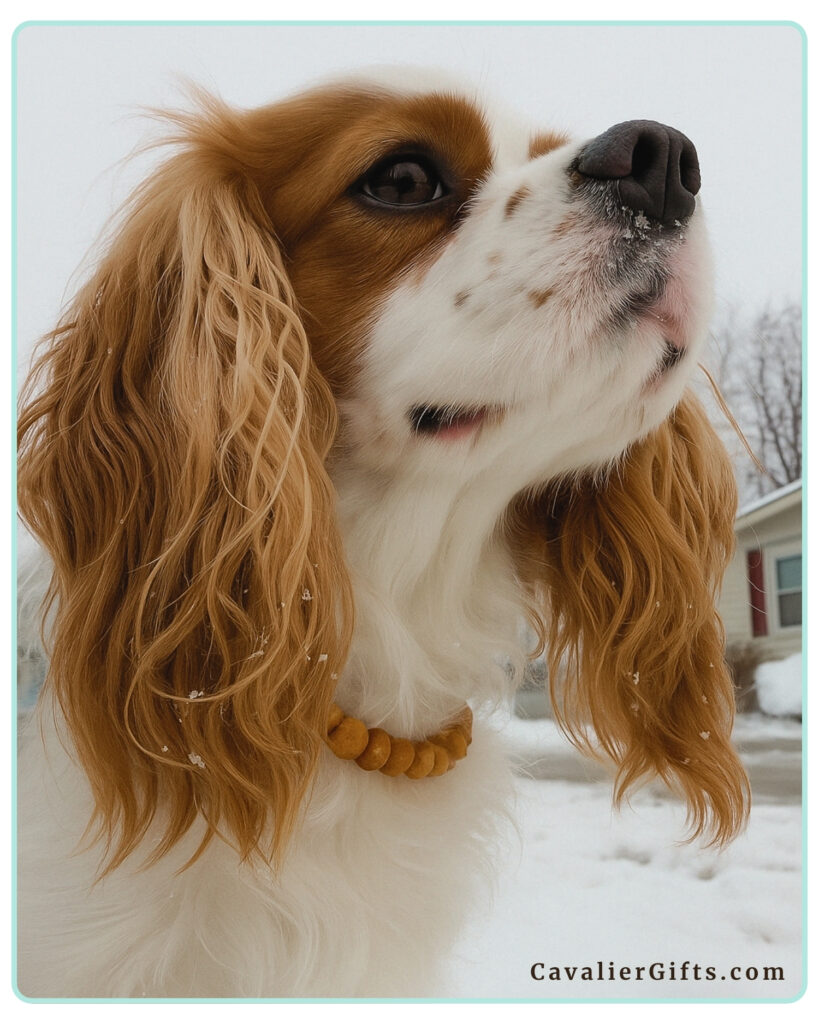

5. Ultrasonic Tick Tags-Another tool to add to your flea and tick routine is an ultrasonic tick tag. There are various brands that make these small devices that clip onto your dog’s collar or harness. They emit a high-frequency pulse that humans and dogs can’t hear, but it’s designed to interfere with a tick or flea’s ability to orient themselves toward your dog.
These tags are scent-free and totally safe for sensitive dogs like Cavaliers. This type of tag is helpful during hikes, trail walks, or visits to areas known for higher tick populations. It’s a simple, noninvasive step that adds an extra layer of protection.
6. Diatomaceous Earth for Natural Flea and Tick Prevention-Food-grade diatomaceous earth is another natural tool I use as part of our flea and tick routine. It’s a fine powder made from fossilized algae that works by drying out the exoskeletons of pests like fleas and ticks. I don’t use it as a primary prevention method, but it’s a helpful layer, especially after we’ve been somewhere with higher pest exposure.
To apply, I lightly sprinkle a small amount down Stewart’s back and gently brush it into his coat, avoiding his eyes, nose, and mouth. It’s best used when your dog is dry and in a well-ventilated area. You can also use it on bedding or around baseboards during flea season as part of a regular cleaning routine.
Watch how I apply it and don’t forget to subscribe to @CavalierTipsandFun YouTube channel for more!
7. Using Garlic to Support Immune Health and Repel Fleas Naturally-Garlic might be controversial in some circles, but when used responsibly, it’s one of my go-to immune support tools. Garlic often gets a bad reputation because in 2000, they did a study on four dogs and gave them an extreme amount of garlic ( about 25 cloves a day for a 25-pound dog), and they had a bad reaction. That’s not even close to how we’d use garlic in a natural, supportive way. You can read the study here.
I started using fresh garlic years ago with Dexter, and it’s something I continue with Stewart now that he’s old enough for it. Garlic supports the immune system and helps repel fleas and ticks from the inside out. I only use fresh, organic garlic, peeled and minced about ten minutes before mealtime to allow the allicin to activate. Then I mix it into Stewart’s food. I never exceed the recommended amount and only feed garlic for up to three days in a row, followed by five to seven days off.
I never use garlic with puppies, pregnant or nursing dogs, dogs with anemia, or those with upcoming surgeries. It’s not a fit for every dog, so I always recommend checking with a holistic vet first.
Garlic Dose For Dogs: The approximate dose of fresh, organic garlic is 1/8 teaspoon for a 5 pound dog, 1/4 teaspoon for dogs between 6 and 10 pounds, 1/2 teaspoon for 11 to 15 pounds, 3/4 teaspoon for 16 to 20 pounds, and 1 teaspoon for dogs between 21 and 30 pounds. Dogs between 31 and 50 pounds can have 1 1/2 teaspoons, and those over 51 pounds can have up to 2 teaspoons.


8. Spotting and Removing Ticks and Fleas from Your Cavalier King Charles Spaniel-No matter how many prevention tools we use, I always do a hands-on check after walks or outings, especially during peak tick season. I check Stewart’s paws, armpits, ears, groin area, and the base of his tail. These are the spots where ticks love to latch on.
If I do find a tick, I remove it immediately with a tick remover or fine-point tweezers, making sure to grab close to the skin and pull straight out. Afterward, I place it in a bottle with alcohol and wash my hands. I’ve found this routine not only gives me peace of mind but also helps me stay in tune with any changes in Stewart’s skin or coat.
A Quick Note About Dexter’s Experience
As Dexter was in his late senior years and his neurological condition progressed, I started to notice the occasional flea here and there, more than we had seen in the past. His immune system wasn’t as strong, and that likely made him more vulnerable to pests. This isn’t uncommon in aging dogs or those with health challenges. Their bodies just don’t have the same defenses they once did.
I made it a daily routine to sit with Dexter and go over him carefully with a flea comb and a small jar of alcohol to catch any runners before they could become a real problem. I also stayed on top of sweeping and washing his bedding regularly. Thankfully, it never got out of control, just a flea here and there, but it reminded me how important it is to stay consistent.
It also reinforced why I’ve always chosen to avoid harsh flea treatments. With Dexter’s compromised system, exposing him to chemicals could have caused even more serious issues. Supporting his health naturally, with gentle and consistent care, was always the safest choice for him.
Final Thoughts on Natural Flea and Tick Care for Cavaliers
If you’re just starting your natural flea and tick care journey, start small. You don’t have to change everything at once. Pick one new step, try it, and see how it fits your dog’s life. Read labels. Ask questions. And most of all, give yourself grace as you navigate what feels right for you and your Cavalier.
Cavaliers are worth the extra effort, and with how sensitive they can be, choosing gentle, natural care just feels like the right thing to do.
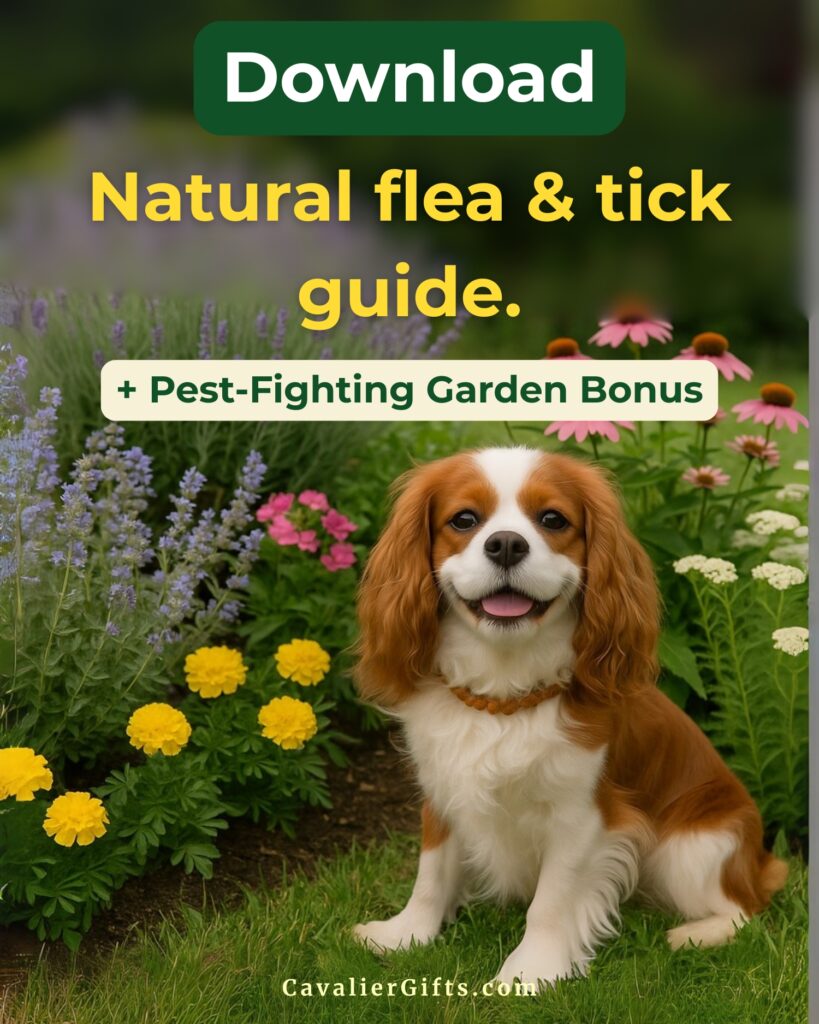

Grab my free Natural Flea and Tick Prevention Guide plus a bonus page on creating a dog-safe garden to help keep pests away naturally. Click to download your free copy!
Google Ad Below
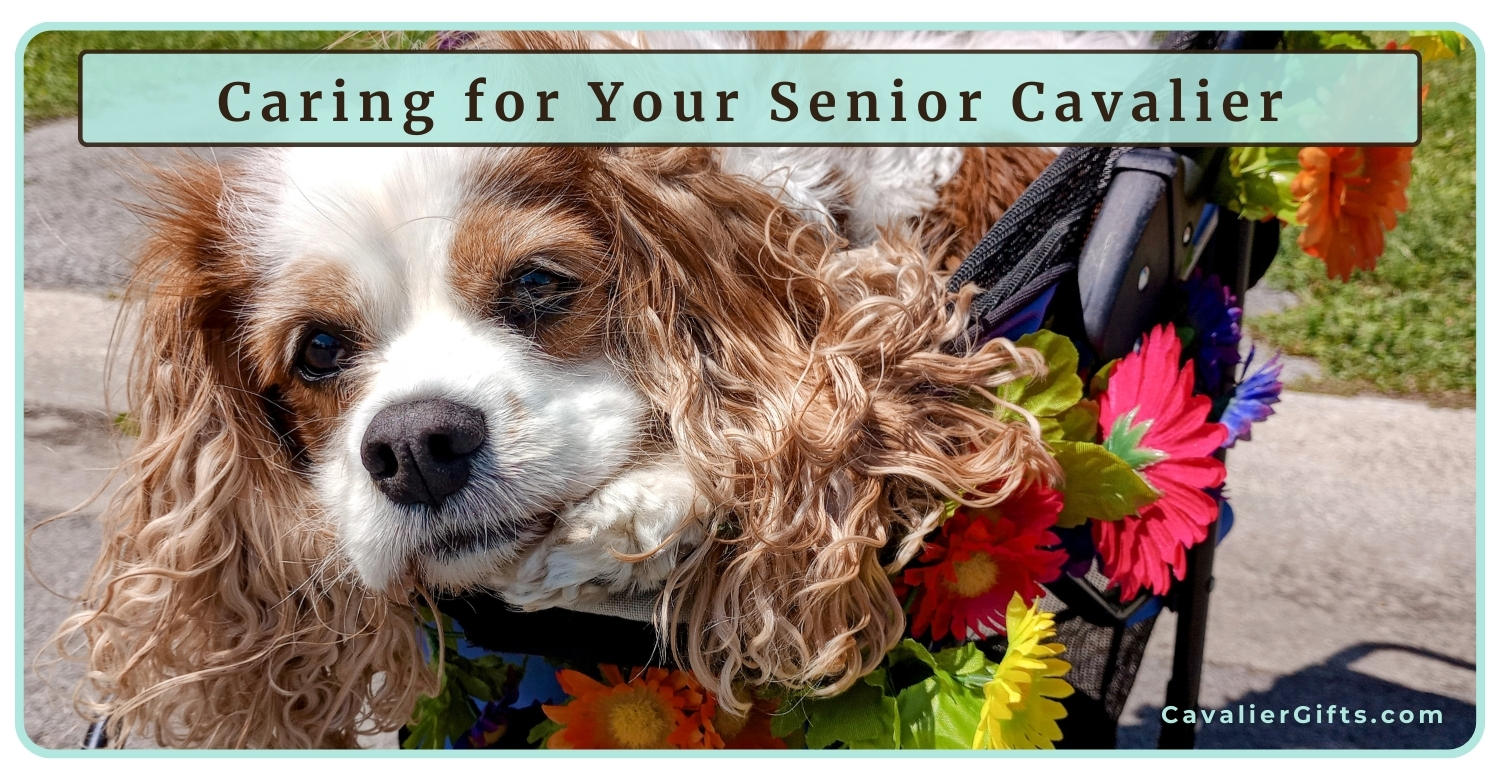

Senior Cavalier King Charles Spaniel Care | When Does a Cavalier Become a Senior? (Early access for our Patreon community)
Supporting Your Senior Cavalier King Charles Spaniel: The Ultimate Guide to Aging Cavaliers








After 15 amazing years with my Cavalier, Dexter it was his time to go to the rainbow bridge. It’s never an easy decision to make and since then, I have been thinking back on our life together. Over the course of his life, I wrote a lot about Dexter on my first blog, Raising Your Pets Naturally. Now, with Stewart, my 7-month-old rescue Cavalier King Charles Spaniel puppy, I’m starting fresh, but with all that I’ve learned from Dexter’s senior years. I thought this would be a good time to explore when a Cavalier King Charles Spaniel is considered a senior, their lifespan, common health concerns, and how we can support our Cavaliers through every stage of life.
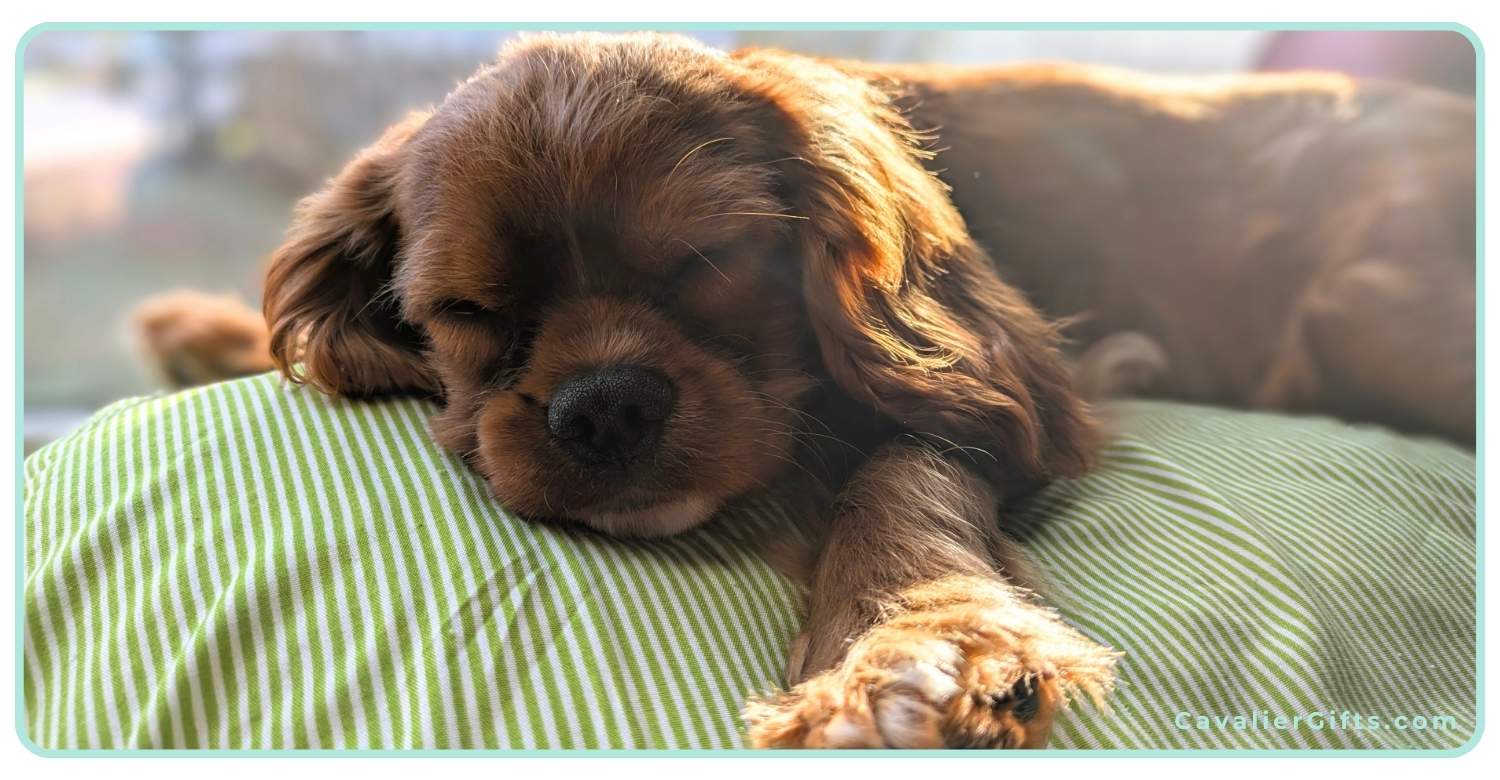

At What Age Is a Cavalier King Charles Spaniel Considered a Senior?
If you’re wondering, “When does a Cavalier reach old age?” The answer varies depending on factors like genetics and health. Typically, small breed dogs like Cavaliers are considered seniors between 7 and 10 years old. While this is a general guideline, you may notice your dog showing signs of aging earlier or later.
Some indicators of senior status include:
- Decreased Interest in Play: They may be less enthusiastic about toys or games they used to enjoy.
- Weight Changes: Unexplained weight gain or loss can be a sign of aging or underlying health issues.
- Changes in Vision or Hearing: Difficulty seeing or responding to cues may suggest declining eyesight or hearing.
- Increased Time Spent Resting: Senior dogs often nap more during the day and may tire easily after exercise.
- Changes in Appetite: They may eat less or show more picky eating habits.
- Difficulty Climbing Stairs or Jumping: You might notice hesitancy or struggle with previously easy physical activities.
- Behavioral Changes: Increased anxiety, clinginess, or even irritability may indicate aging.
- Frequent Bathroom Breaks: Aging can bring bladder control issues or an increased need to urinate.
- Dull or Thinning Coat: Their fur might lose its luster or feel thinner in certain areas.
- Dental Issues: Bad breath, difficulty chewing, or loss of teeth can become more prominent.
- Reduced Tolerance for Cold or Heat: Seniors may seek out warmth or avoid strenuous activity in hot weather.
- Increased Vocalization: They may bark or whine more often, potentially due to discomfort, anxiety, or confusion.
- Cognitive Changes: Signs of canine cognitive dysfunction (CCD) include disorientation, restlessness, or forgetting familiar routines.
- Slower movement or stiffness in the morning: Your Cavalier may take a little longer to get going in the mornings, which can be a sign of joint stiffness or early arthritis.
- Graying fur, often around the muzzle: Just like humans, dogs may develop gray hairs as they age, particularly around their face.
But don’t worry, aging doesn’t mean your Cavalier is slowing down in spirit! With the right care and attention, they can still enjoy life to the fullest.


What Is the Life Expectancy of a Cavalier?
You may have heard the question, “How long do Cavaliers live?” The average lifespan of a Cavalier King Charles Spaniel is approximately 10.45 years. This is based on a 2022 UK study of veterinary data. However, some studies suggest a slightly longer lifespan, with a 2024 UK study indicating an average of 11.8 years for the breed. The typical lifespan of a Cavalier King Charles Spaniel is around 9-14 years. That said, some Cavaliers, like Dexter, surpass this average with proper care, while others may face challenges earlier due to health conditions.
Common Health Issues in Cavaliers
Cavaliers are an incredibly loving and joyful breed, but they do have a predisposition to certain health issues. Knowing what to watch for and being proactive in their care can help them live a happy and long life.
- Mitral Valve Disease (MVD): Nearly every Cavalier King Charles Spaniel owner will face mitral valve disease at some point if their dog lives long enough. This heart condition affects the valve’s ability to close properly, leading to a heart murmur and, eventually, heart failure if untreated. Yearly heart check-ups with a cardiologist can help monitor and manage this condition.
- Chiari-like Malformation (CM): Because of the breed’s unique head shape, it’s estimated that 95 to 99% of Cavaliers will develop a condition called Chiari-like malformation (CM). This happens when the skull is a bit too small for the brain, causing part of the brain to push into the spinal canal. CM can result in pain, weakness, or in severe cases, even paralysis. While there’s no cure, symptoms can often be managed with medications and regular vet check-ups, helping your dog feel more comfortable.
- Hip Dysplasia and Patella Luxation: While less common in Cavaliers compared to larger breeds, these conditions can cause joint pain and mobility issues. Patella luxation, which is a dislocation of the kneecap, is more common in Cavaliers and can lead to lameness and discomfort. Keeping your Cavalier at a healthy weight is key to reducing stress on their joints and managing these conditions.
- Eye and Ear Problems: Cavaliers are prone to progressive retinal atrophy (PRA), cataracts, and ear infections. Regular grooming and vet visits help catch these issues early.
- Intervertebral Disc Disease (IVDD): IVDD is a condition where the discs in your dog’s spine become damaged or degenerate, causing pain, weakness, or even paralysis in severe cases. Cavaliers are particularly vulnerable to this, especially as they age. Be on the lookout for signs of discomfort, difficulty moving, or dragging their back legs.
- Myoclonus: Myoclonus refers to muscle twitches or jerks that can occur in Cavalier seniors, especially around the head or neck area. While it’s usually not painful, it’s important to consult with a vet to rule out underlying issues such as neurological problems.
- Medium-Chain Acyl-CoA Dehydrogenase (MCAD) Deficiency: This genetic condition affects Cavaliers’ ability to properly metabolize certain fats, which can lead to serious health problems, including low blood sugar, lethargy, and, in severe cases, sudden death. The great thing is that there’s a quick and easy at-home swab test available to check if your Cavalier has MCAD. It’s a simple step that can give you peace of mind and help catch this condition early. It’s a proactive way to care for your Cavalier’s long-term health.
Subscribe to @CavalierTipsandFun for more!
Supporting Your Cavalier Through All Life Stages
Caring for a senior Cavalier means making thoughtful changes to their routine. As our dogs get older, their needs shift in different ways. They may slow down, develop new health concerns, or simply need more comfort. These changes are completely normal, and it’s up to us to help them adjust so they can continue to feel their best. With a little extra care and attention, we can make sure they stay happy, healthy, and comfortable as they age. Whether it’s modifying their diet, adjusting their exercise, or making small changes to your home, these little changes go a long way in supporting their well-being. After all, they’ve given us so many wonderful years of love and companionship, and now it’s our turn to return the favor.
Nutrition for Senior Cavaliers
As your Cavalier enters their senior years, their nutritional needs often shift to support their changing bodies. A balanced diet made with fresh, high-quality ingredients like Omega-3s, antioxidants, glucosamine, and chondroitin can help maintain joint health, cognitive function, and overall vitality. Glucosamine and chondroitin play an essential role in supporting cartilage and joint health and can be included in their diet through natural sources like bone broth, chicken feet, or beef trachea, or through supplements if needed. Adding these fresh foods as part of their meals or even as toppers can provide a natural boost that processed options often lack. Every dog is unique, so working with your vet or a canine nutritionist is key to crafting a plan that meets your Cavalier’s specific needs.
When Dexter was diagnosed with kidney issues in his senior years, I found that his diet needed some adjustments. He had been raw-fed for most of his life, but with the help of his veterinarian, I transitioned him to a customized, home-cooked diet to better support his health. Bones, which are a staple in raw feeding, are high in phosphorus, a mineral I needed to limit. To make up for the lack of bone calcium, I switched to eggshell calcium, which is lower in phosphorus and just as effective.
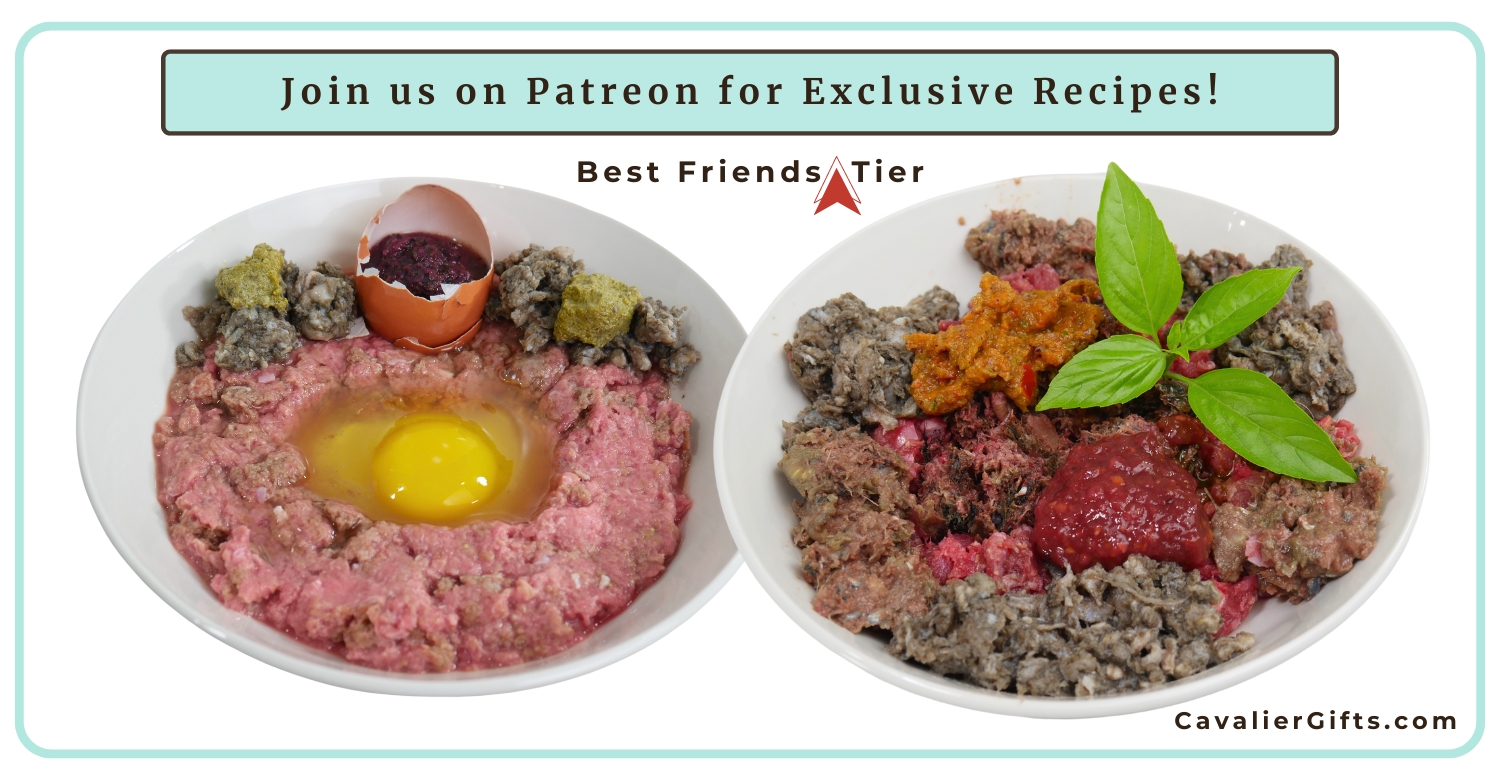

I also began boiling his meat and discarding the cooking water, which helped reduce the phosphorus content even further. I carefully selected foods that were naturally lower in phosphorus, like certain vegetables and proteins. Dexter was also starting to lose weight, so I added carbs like rice and sweet potatoes to help him maintain his energy and body condition.
These changes made a big difference in his quality of life. While home-cooking may not be for everyone, it’s worth exploring alternatives to prescription diets if your Cavalier develops a medical condition. A good veterinarian or certified dog nutritionist can guide you in creating a plan that meets your dog’s needs without compromising on fresh, wholesome ingredients.
💡 Pro tip: Every Cavalier is unique, and what works for one dog may not work for another. Always partner with your vet or a canine nutritionist to find the best approach for your senior Cavalier. Giving them a fresh diet tailored to their needs is one of the best ways to show your love and care during their golden years.
Exercise and Mental Enrichment
Gentle exercise is important for keeping your senior Cavalier feeling their best, but it’s all about adjusting to their abilities. When Dexter reached his senior years, mosey walks became our go-to. He loved taking his time, sniffing every blade of grass, and enjoying the world at his own pace. When he got tired, I’d pop him into his stroller so we could continue our adventure without overdoing it. That stroller wasn’t just for outdoor strolls either, it was perfect for indoor store adventures, allowing him to stay engaged and part of the action while giving his body the rest it needed.
Mental enrichment was just as important as physical exercise. One of Dexter’s favorite activities was a “find it” game with cardboard boxes. I’d hide a treat in a box, spread them around, and watch his excitement as he used his nose to uncover the prize. It was the perfect mix of mental stimulation and gentle movement. For senior Cavaliers, simple adjustments like these can make a huge difference. Whether it’s a slow walk, a stroller ride, or an engaging puzzle, finding activities that fit their needs helps them stay vibrant and connected to the world around them.
Don’t forget to subscribe to @CavalierTipsandFun for more!
Natural Therapies for Senior Cavaliers
As Cavaliers age, their bodies may need extra support to stay comfortable and mobile. Therapies like at-home laser treatments, physical therapy, and acupuncture made a big difference for Dexter in his senior years. Actually, Dexter had these treatments the majority of his life due to his Chiari malformation. These options can reduce pain, improve mobility, and help manage chronic conditions like arthritis.
Dexter had regular physical therapy visits, where he worked with a canine rehabilitation specialist to keep his joints moving and his muscles strong. I also had simple at-home exercises to follow up with between visits, ensuring he stayed as active as possible without overdoing it. Using a laser therapy device at home helped target areas of stiffness or soreness, and his PEMF (Pulsed Electromagnetic Field) bed became one of his favorite spots to rest. PEMF therapy didn’t just support his comfort but also promoted better circulation and reduced inflammation.
Order a laser for your Cavalier today!
Acupuncture was another natural treatment that worked well for Dexter, offering gentle relief from discomfort and improving his overall quality of life. These treatments, along with his regular routine, were all part of ensuring he was comfortable and able to enjoy his senior years to the fullest.
If you’re considering these therapies for your Cavalier, talk with your Cavalier’s holistic vet or a canine rehabilitation specialist. They can guide you toward the best options for your Cavalier’s individual needs and help create a plan to support their comfort and mobility.
Veterinary Care and Preventative Check-Ups
Regular vet visits are essential, especially as your Cavalier gets older. I recommend scheduling check-ups at least once a year, but if your dog is on medications or managing a condition, like Dexter was, labs every 4 months can give you a better picture of their health. Semi-annual check-ups are also a good idea to catch early signs of issues like MVD, joint problems, or anything else that may need attention. Don’t hesitate to bring up any subtle changes you’ve noticed, whether it’s weight loss, fatigue, or coughing. Early intervention is key, and your vet can provide valuable guidance to help you manage your Cavalier’s health, ensuring they stay happy and comfortable as they age.
Cardiologist Visits
I highly recommend that every Cavalier sees a cardiologist at least once a year. Cardiologists specialize in heart health and truly understand the ins and outs of heart disease, including conditions like MVD, which Cavaliers are prone to. Even if your dog hasn’t been diagnosed with anything serious yet, a cardiologist can spot early signs of issues that might not be apparent to you or your regular vet. If your Cavalier is diagnosed with MVD, your cardiologist may recommend more frequent visits to monitor the progression of the disease and adjust their treatment plan as needed. Having a heart specialist on your team gives you peace of mind and ensures you’re taking proactive steps to care for your dog’s heart health.
Making Your Home Senior-Friendly
As your Cavalier enters their senior years, small changes around the house can make a world of difference in how they move and rest. Senior dogs often experience joint stiffness, and their mobility may not be what it once was, so providing a comfortable and safe environment helps them feel at ease. These adjustments don’t have to be drastic, but they can really support your dog’s needs as they age.
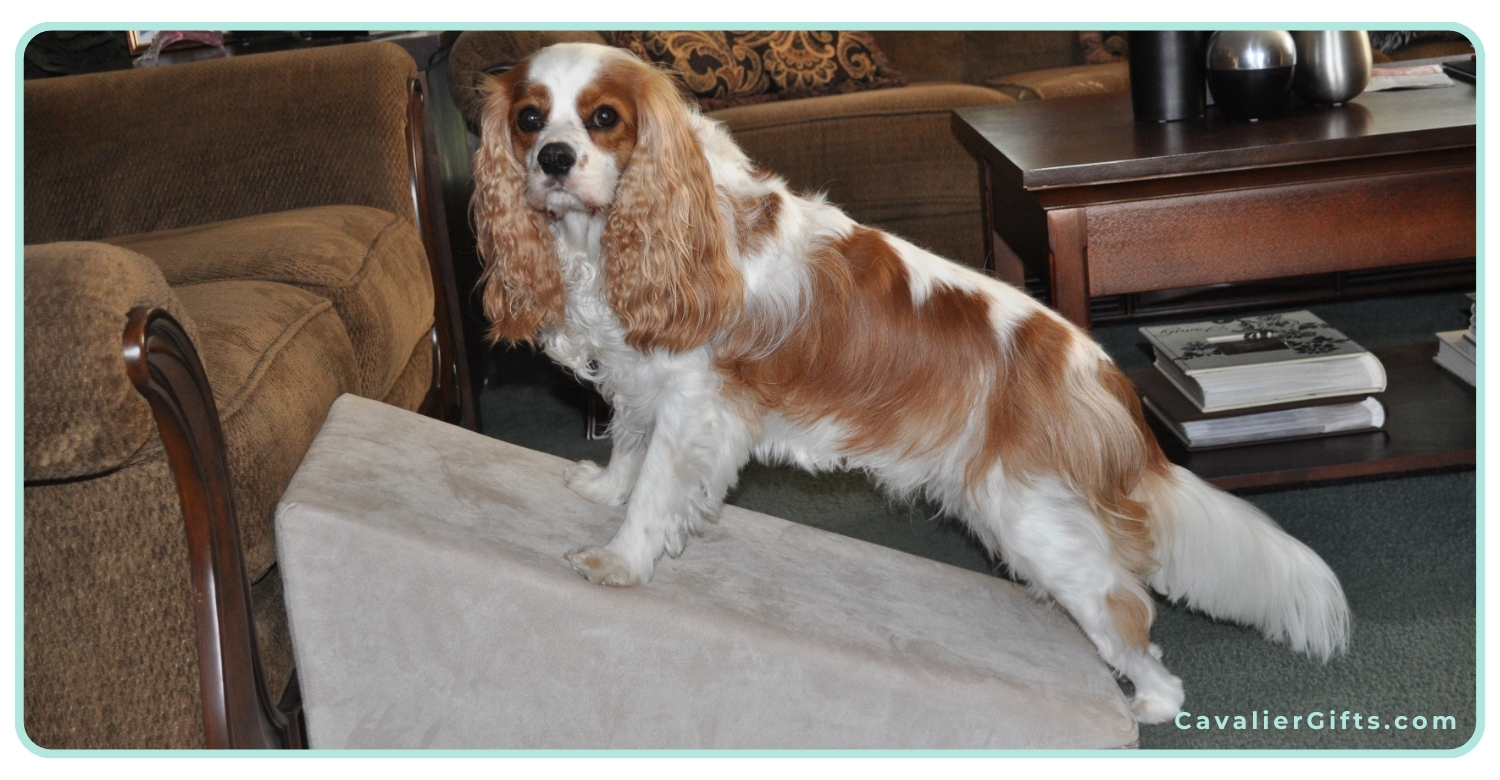

- Ramps or Steps: It’s always a good idea to have ramps or steps in place, even if your Cavalier is still young. Jumping down from furniture can put strain on their joints and neck, leading to potential issues down the road. Ramps or steps make it easier for them to get on and off the couch or into the car, preventing unnecessary stress on their bodies. These additions are a simple way to protect your Cavalier from injury and support their mobility throughout all stages of life, ensuring they can continue to join in on the fun without risk.
- Orthopedic Beds: Comfort is key when it comes to senior Cavaliers. Cushioned orthopedic beds provide much-needed support for aging joints and pressure points. Dexter was a fan of cooling mats all year, so I made sure to place them throughout the house, including on his beds, to keep him cool. But I always left at least one bed without a cooling mat, in case he wanted to curl up and stay cozy. The goal is to ensure they have a comfortable place to rest, with options that suit their changing needs.
- Non-Slip Surfaces: Slippery floors can be a senior dog’s worst enemy. To prevent falls, I recommend adding rugs or carpets to high-traffic areas, especially in places like the kitchen or hallway. You can also try ToeGrips(use promo code: DEXTER for 10% Off Your First Order), which help with traction, so your Cavalier can walk confidently. Making sure they have a stable environment to navigate helps keep them safe, especially when they’re getting around slower than they used to.
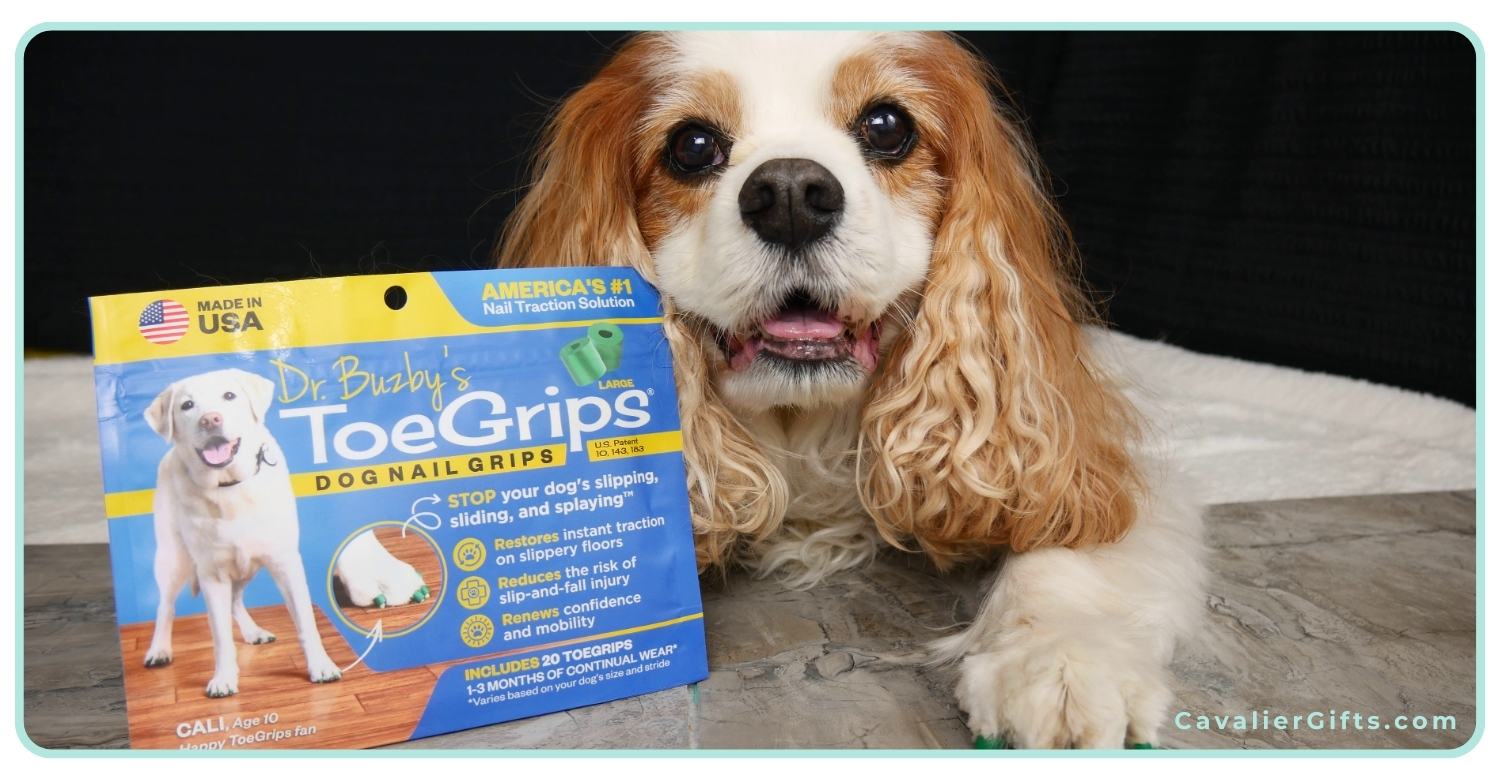

How Long Do Cavaliers Live? Cherish Every Moment
If there’s one thing Dexter taught me, it’s to appreciate the little moments, whether it was a slow morning walk, the rare occasion when he’d want to be close and rest in the nook of my legs, or simply watching him nap and snore in the sunshine. Dexter wasn’t much of a cuddler, but when he wanted to be near me, I made sure to savor those times. Our Cavaliers may not live as long as we’d like, but the joy they bring into our lives is something we’ll never forget.


When Stewart reaches his senior years, I know I’ll be ready to give him the care and love he deserves. For now, I’m soaking up every playful, puppy-filled moment.
|
|
      
|
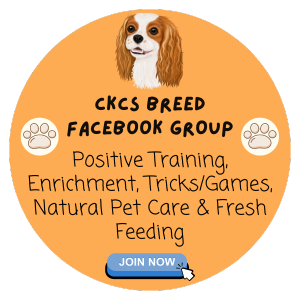      
|
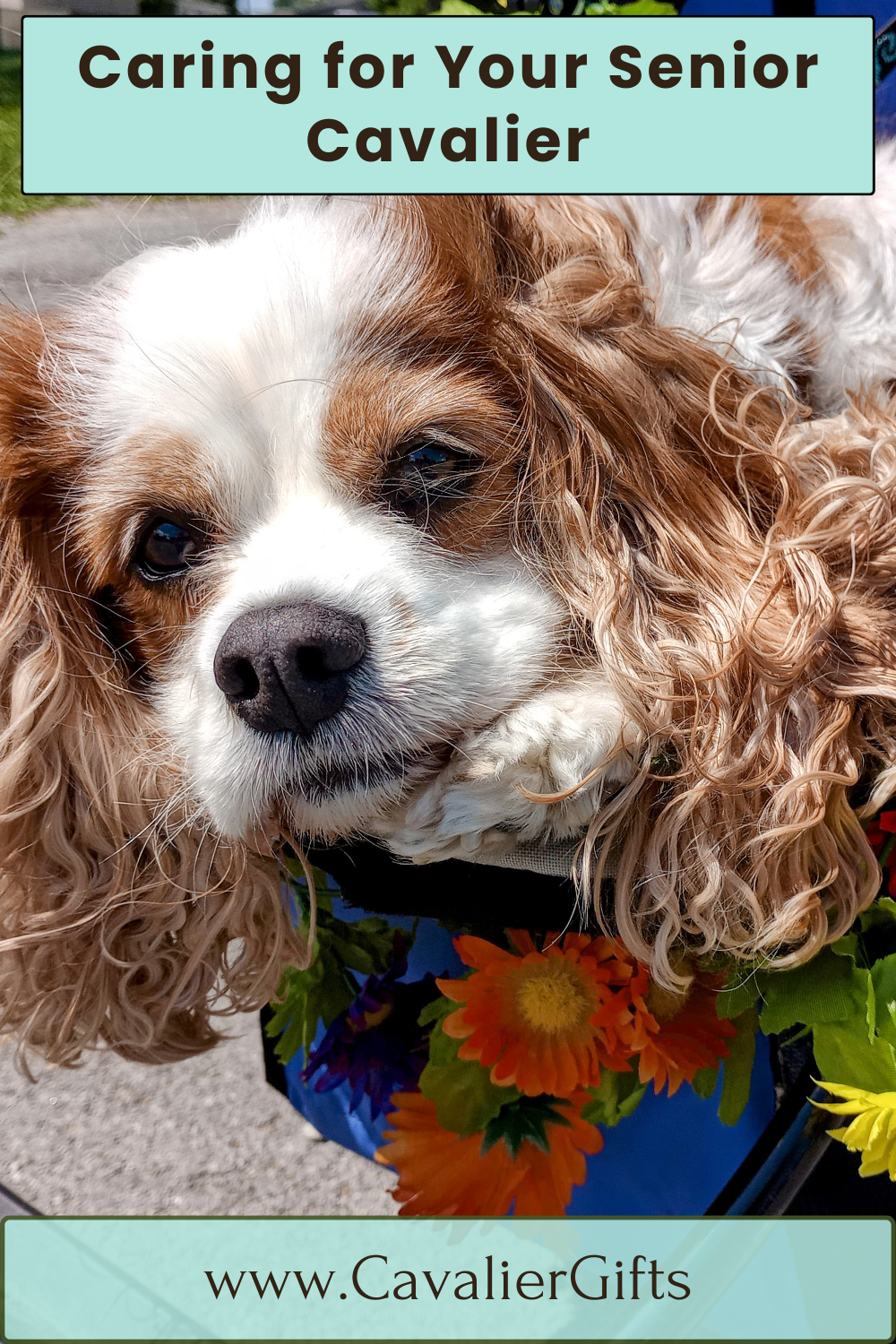

Google Ad Below
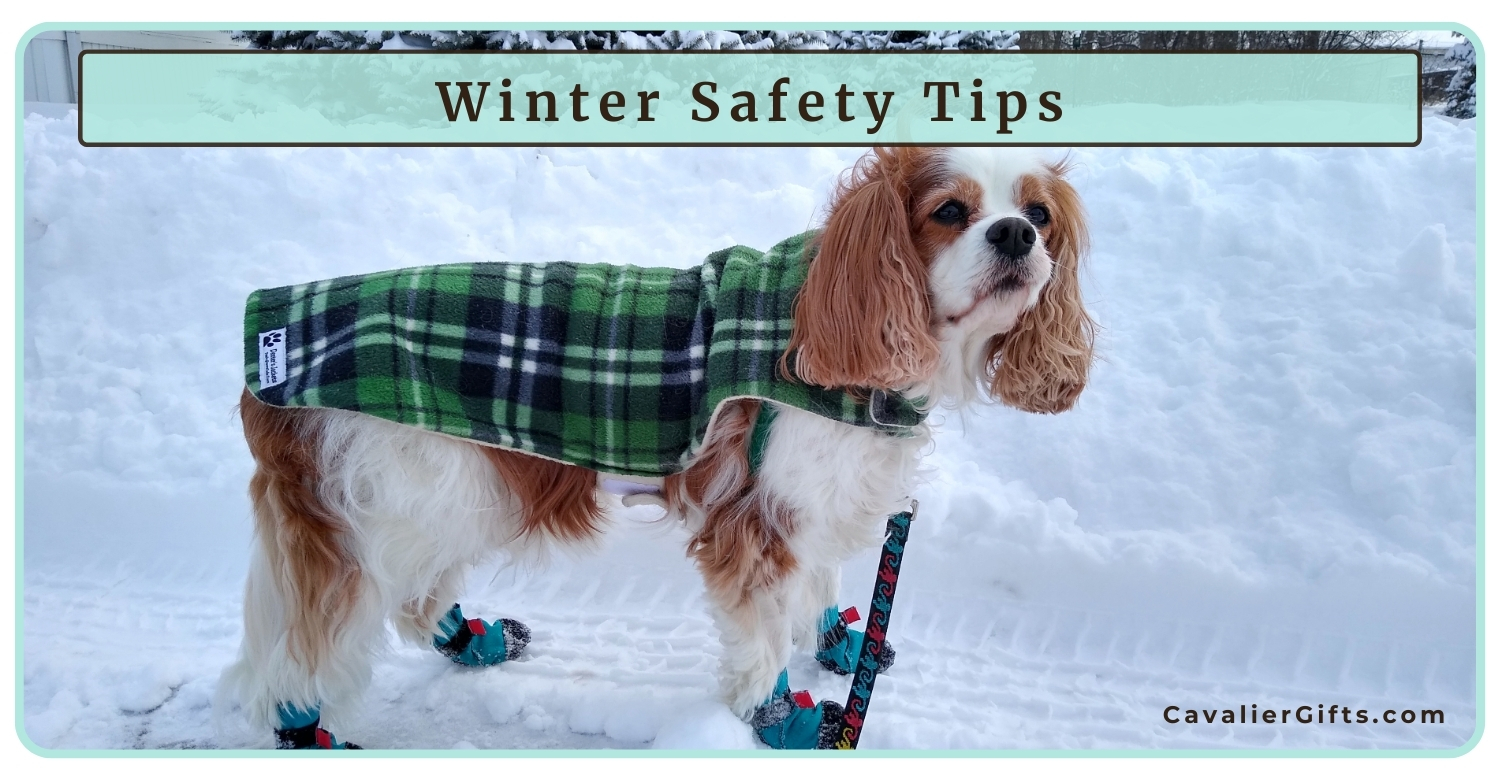

Winter Safety Tips for Your Cavalier King Charles Spaniel: Keeping Your Cavalier Warm in the Winter (Early access for our Patreon community)
Winter Tips for a Cavalier King Charles Spaniel








Brrrr, it’s cold out there! Winter in Ohio can be tough, and today, it’s a chilly 15 degrees. Thankfully, Stewart and I are bundled up inside, but it’s the perfect time to share some essential winter safety tips for your Cavalier King Charles Spaniel. Whether you’re venturing outdoors or staying warm indoors, these precautions and activities will help keep your pup safe, healthy, and happy all winter long.
Safety First: Protecting Your Cavalier in Winter
Limit Outdoor Time
Our Cavaliers are family members, and they thrive indoors with us. While Stewart loves his outdoor potty breaks and a quick sniff around the yard, I always limit his time outside when temperatures dip. Frostbite and hypothermia are real risks for dogs, especially small breeds like Cavaliers. Keep outings short, and always monitor your pup for signs of discomfort.
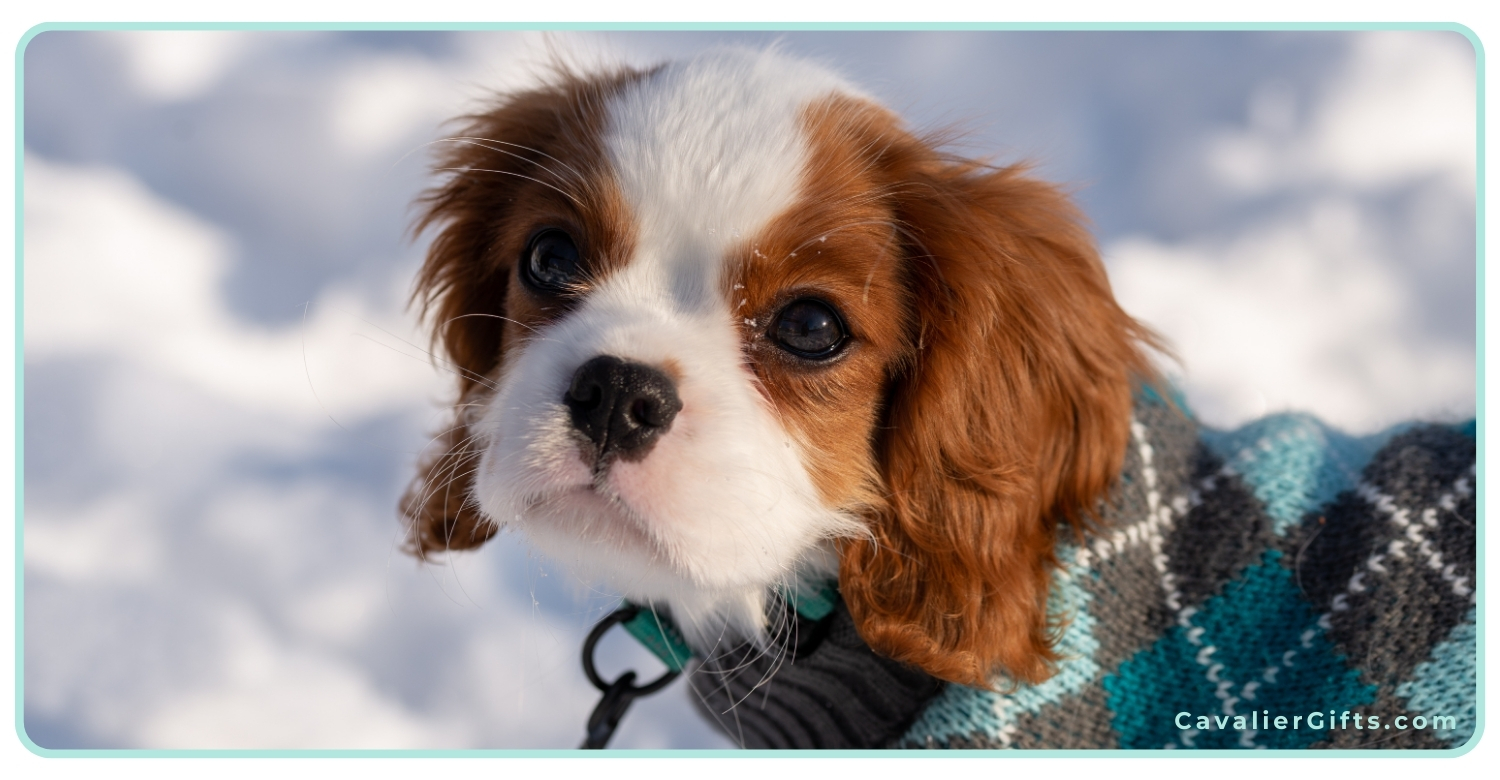

Protect Those Paws
A dog’s paw pads aren’t built to handle extreme cold or icy surfaces. For quick potty breaks, toddler socks can be a lifesaver; they’re easy to put on and don’t need to be perfect since they’re just for a short trip. Shoot for dark colors, so that if one falls off, it’s easier to find in the snow. For longer walks or outdoor play, dog boots like Saltsox are fantastic options. If your Cavalier goes outside barefoot, be sure to clean their paws thoroughly with a warm washcloth or natural pet wipes to remove ice, salt, and chemicals that could irritate their skin. I make up a bowl of water with a splash of 4-Legger shampoo and a washcloth to clean paws. I make a new batch each day. (Order 4-Legger today with promo code RaiseNaturally20 for 20% off your first order.)
Scoop the Potty Area
I always scoop a clean, clear area in the yard for potty breaks. Cavaliers, like most dogs, prefer a neat spot for their business. A wide, shoveled path ensures your Cavalier can move around comfortably without getting buried in snow.
Coats and Sweaters for Your Cavalier
Dog coats and sweaters are a must for Cavaliers. Look for a jacket that provides full range of motion and covers your pup’s back and belly. Indoors, a cozy sweater can keep your Cavalier comfortable. If you notice your Cavalier sleeping in a tight ball, or even shivering, a dog sweater is a great idea. Stewart’s favorite sweaters are custom-made by MeekByDesign, but there are plenty of great options online or in pet stores.
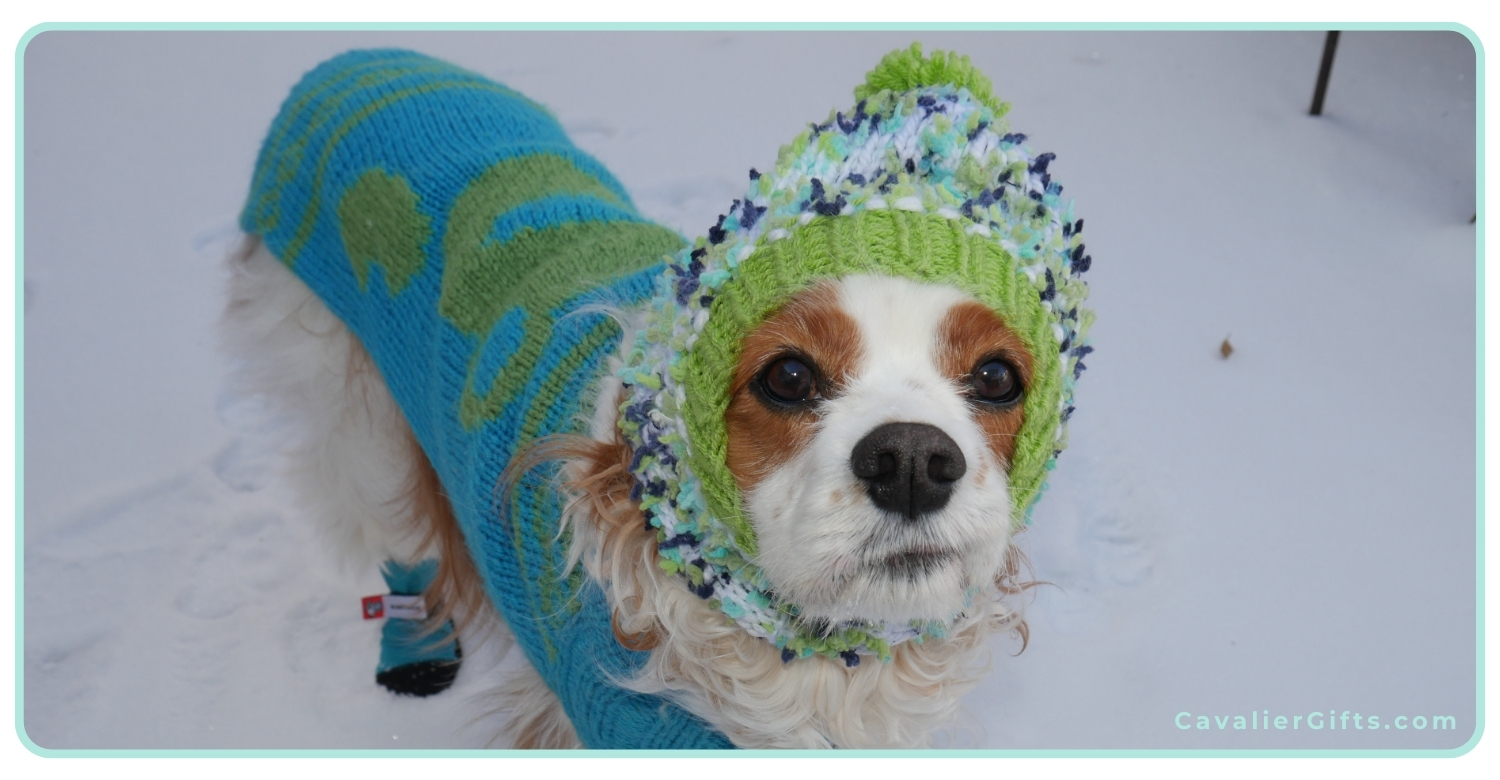

Should a Cavalier Wear a Hat in the Winter?
Cavaliers’ long, luxurious ears attract snow and ice like a magnet! A lightweight dog hat or snood can protect your Cavalier’s ears during snowy adventures. Afterward, be sure to dry their ears gently with a soft towel.
Staying Warm and Cozy Indoors
When your Cavalier comes inside from the snow or cold, use a super-absorbent microfiber towel to dry him off thoroughly. For an extra touch of luxury, I like to pop a favorite blanket in the dryer so my dog can snuggle up with something warm. These little comforts make a big difference on chilly days!
Indoors, I keep Stewart active and engaged with puzzle toys, hide-and-seek games, and short training sessions. A mentally stimulated pup is a happy pup, even when it’s too cold for a long walk.
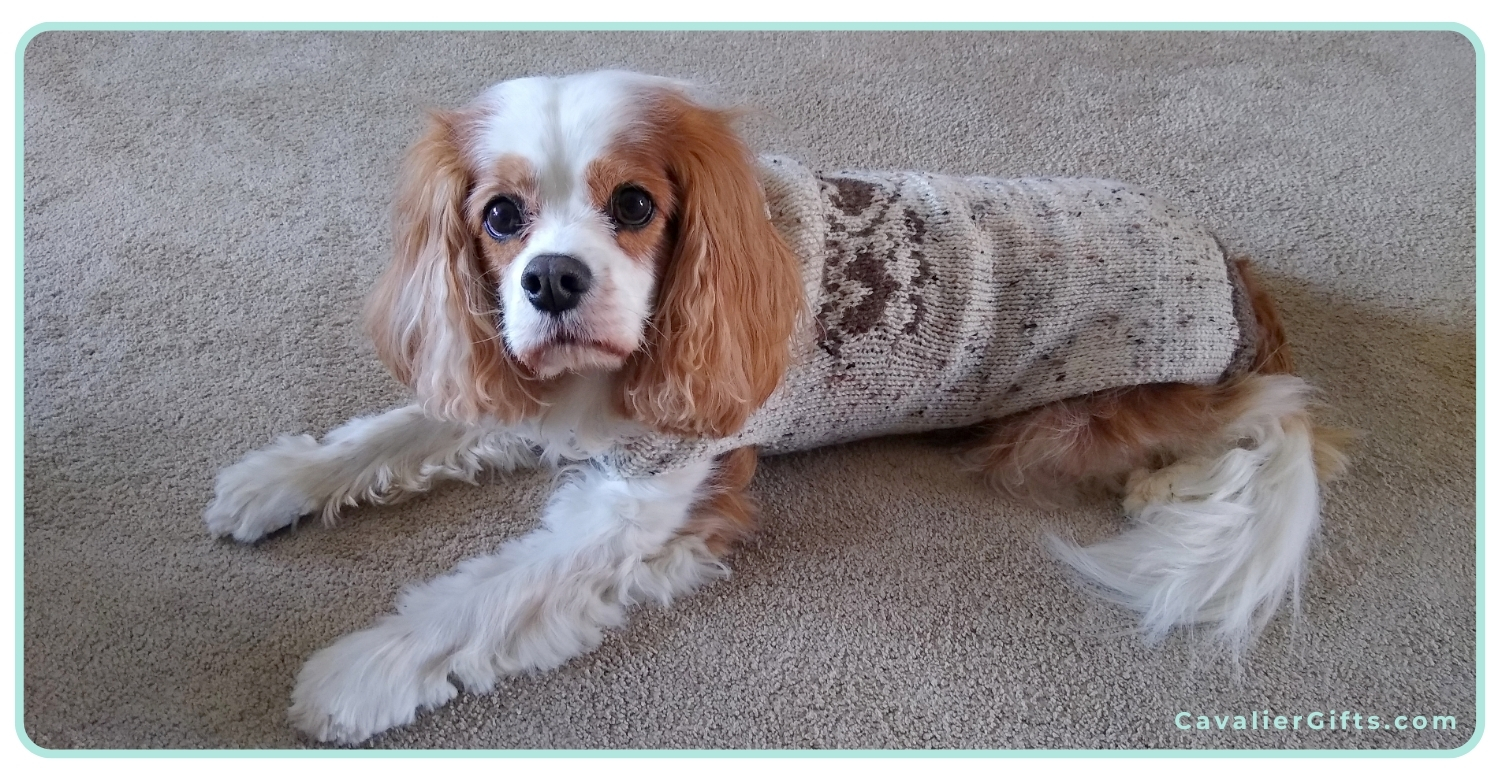

Winter Nutrition for Cavaliers
Did you know that certain foods can help your Cavalier King Charles Spaniel stay warm during the chilly months? According to Traditional Chinese Medicine (TCM), foods have energetic properties that can influence the body’s temperature and overall balance.
In the winter, it’s beneficial to incorporate “warming” proteins into your dog’s diet. Proteins like chicken, lamb, venison, and even goat are considered warming and can help offset the cold temperatures. These proteins are especially good for dogs who seem more sensitive to the cold or have lower energy during the winter.


You can also include warming spices and herbs like ginger or turmeric in small, dog-safe amounts to add a cozy touch to their meals. These not only are warming, but also support joint health during cold weather.
If you’re new to adjusting your dog’s diet seasonally, start slow by adding one or two warming ingredients to their current meals. Always consult with your vet or a canine nutrition expert to ensure your Cavalier’s diet remains balanced and meets their individual needs.
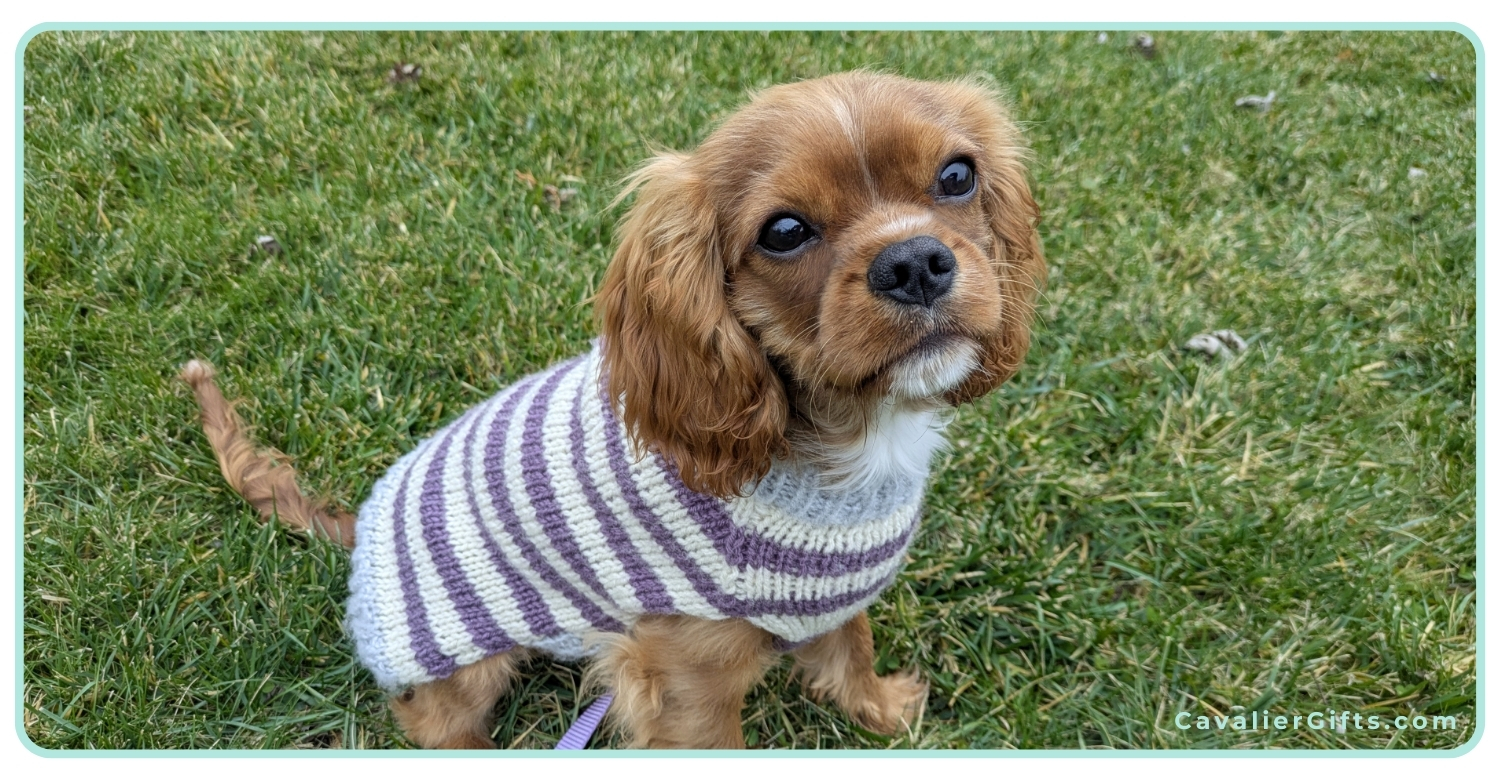

Embrace the Season
Stewart may be new to my home, but we’re already making the most of winter together. From brisk walks in his cozy new jacket to snuggling under a warm blanket on chilly evenings, these little moments remind me of the special bond we share. No matter the season, Cavaliers have a way of bringing warmth and joy to our lives.
How do you keep your Cavalier comfortable and happy during the winter months? Share your tips below, I’d love to hear them!


|
|
      
|
      
|


Google Ad Below
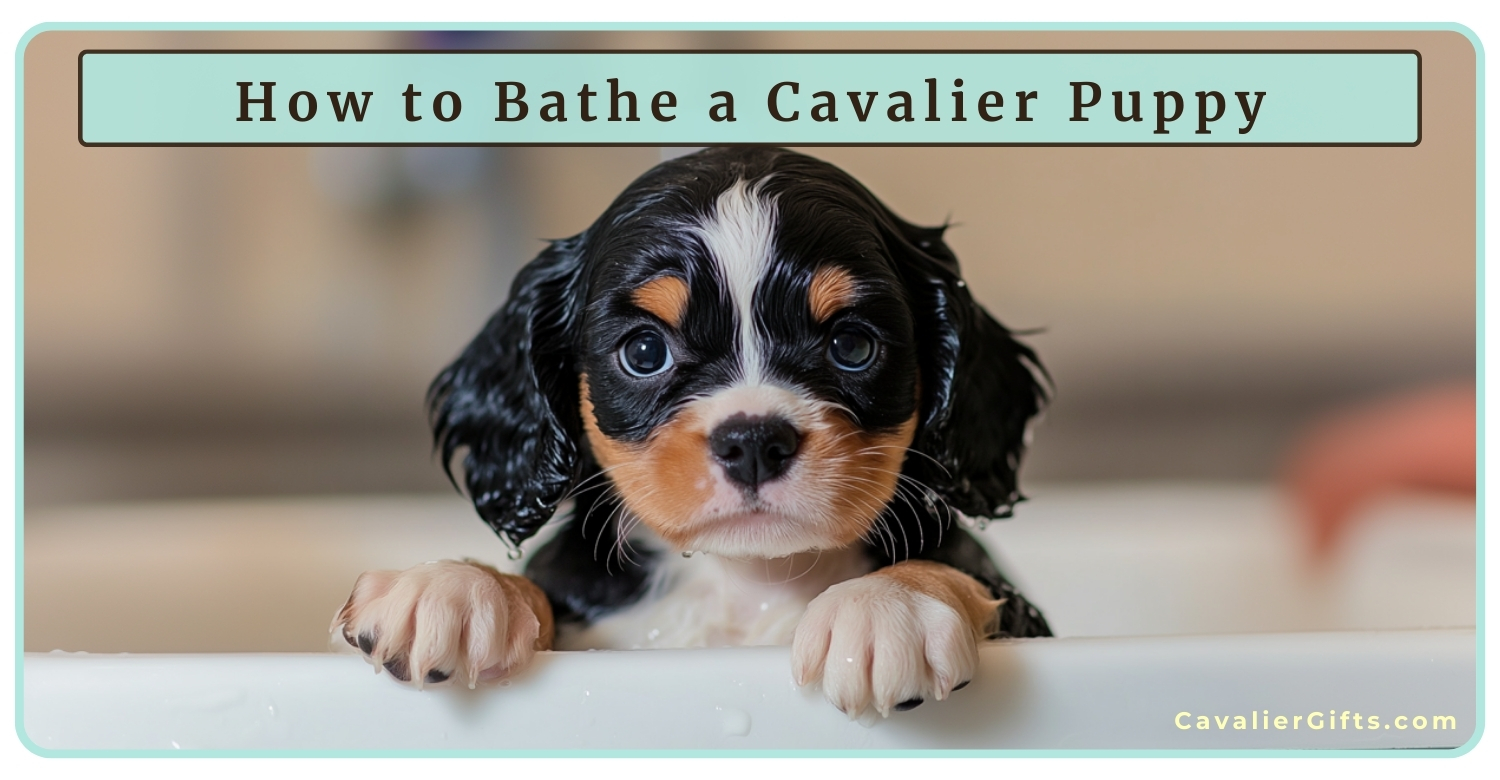

How to Bathe a Cavalier Puppy for the First Time: Willow’s Bath Time Adventure! (Early access for our Patreon community)
How to Bathe a Cavalier King Charles Spaniel Puppy








If you are wondering how to bathe a Cavalier King Charles Spaniel puppy at home, I have you covered. As a Cavalier mom and positive dog trainer, I’m ready to help you make bathing your Cavalier puppy not only effective but enjoyable and stress-free for your new Cavalier King Charles Spaniel puppy.
Dexter, who is now fifteen, has had his fair share of dog baths. But, today, I’m going to share how I gave Willow her first bath at home. With the right setup, some tasty treats, taking it slow, and a cozy towel, you can create a zen atmosphere for your Cavalier’s bathtime. So here’s a step-by-step guide to giving your Cavalier King Charles Spaniel puppy their first bath.
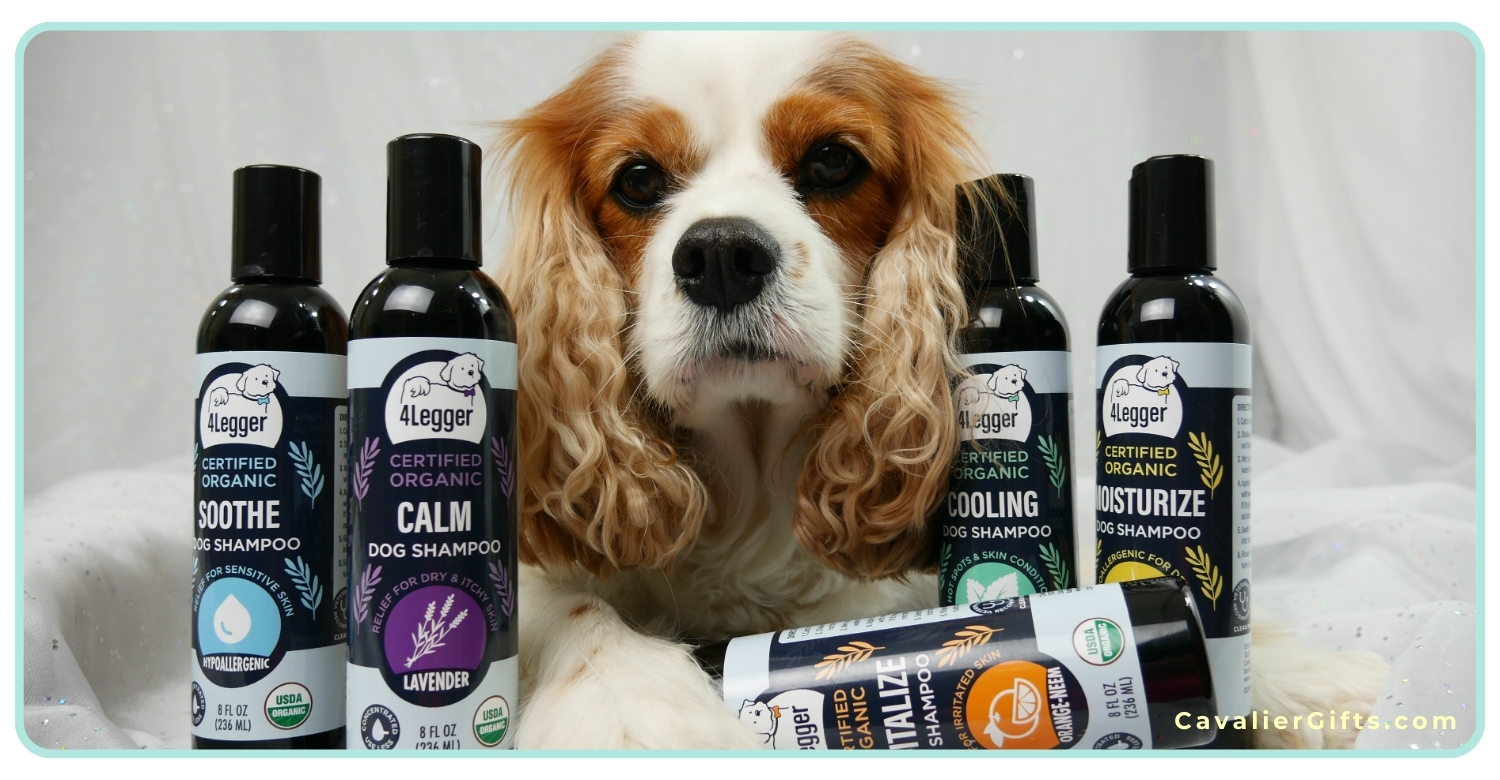

Set Up Your Puppy’s Bath Space for Safety and Comfort
First, you want to ensure your puppy’s bathtub or sink is safe and secure. You don’t want your puppy slipping on the surface of a wet tub or sink. First things first-secure the bathtub or sink so your puppy won’t slip. A good rubber mat keeps your Cavalier from slipping, and this alone will help your puppy feel safer in the tub. If your Cavalier is small, like Willow, you can easily bathe them in the sink. But, if they are larger, like Dexter, a tub is a must, or a portable dog bathtub can also work well. I haven’t used one, but I’ve heard from other Cavalier families they are great!
Warm Towel Tip: Before starting your puppy’s bathtime, place a few towels in the dryer. Then, just before you head to the bath, grab the warm towels. Then, after bathtime, your puppy can be wrapped in a warm-and-cozy towel. If you air dry your Cavalier puppy, then add some puppy blankets too, so they can cozy up in the pile of warm blankets.


How to Choose a Puppy Shampoo That is Safe
When choosing a safe puppy shampoo, the first stop is the back of the shampoo bottle to read the entire ingredient panel. Yup, you want to read each ingredient and make sure those ingredients are safe and natural. You may be surprised at the garbage that you find in some puppy shampoos.
Full disclosure, I’ve been working with the 4-Legger brand since 2016 and, in my opinion, they are the best out there. For puppies, I like their hypoallergenic SOOTHE formula. This isn’t a puppy shampoo review, but I do want to share their ingredient panel, so you can get a better idea on what a good puppy shampoo looks like.
4-Legger SOOTHE Ingredients: Organic Aloe Juice, Organic Saponified Oils (Coconut, Shea Butter, Olive, Sunflower, and Jojoba), Organic Vegetable Glycerin, Organic Rosemary Extract Order today with promo code RaiseNaturally20 for 20% off your first order.
Keep Your Cavalier’s Inner Ears Dry
Protecting those little ears is important. You can place a cotton ball gently in each ear to prevent water from sneaking in, but remember to remove them after! Or, you can simply gently press their ear to their head as you use a warm washcloth.
Be Generous with the Tasty Treats or Lick Mats
Treats are key to conditioning your puppy that bathtime is good. Bath=Treats or Bath=Lick Mat Time Giving treats throughout the bath not only keeps it positive but also helps distract them from what is going on. Talk to your Cavalier puppy through the experience. Let your puppy know how much you love them and that this is a safe experience.
If you’re looking for more gentle routines and everyday training ideas like this, my Manners, Life Skills & Foundation Training Course walks you through simple, trust-based lessons you can use at home. It’s all about helping you and your dog feel confident and connected.
Watch Willow’s First Bath and don’t forget to subscribe to @CavalierTipsandFun for more!
Introduce Your Puppy to the Bath Gently
When it’s go-time, place your puppy gently in the sink or tub. Willow was a little unsure at first, so I kept things calm and encouraging. We went slowly, allowing her to get comfortable, and rewarded her bravery with treats. You can always do this in steps over a few days if your puppy is nervous. Teaching your Cavalier puppy to enjoy a bath is going to be so important since this is a breed that can benefit from baths to keep their luxurious coat beautiful. The benefit of puppy bathing is that the process can be much shorter than when your Cavalier has a full coat.
Start the Water Slowly
Once your puppy seems a bit settled, turn on the water. Using a shower sprayer is ideal because it’s easier to manipulate around your Cavalier and get the belly and bum area easier. Always check the temperature; you want it warm, but never hot. If your pup gets nervous, reassure them with gentle touches, talk to them, and provide healthy and tasty treats. We want bathtime to be a good thing, not something to avoid.


Wet Your Puppy and Lather Up
Begin with their back, avoiding their face for now. Once they’re damp, add a little shampoo and lather gently. Go slow and talk to your pup throughout to keep them reassured. Make sure to reach all those little spots like under the belly, armpits, and legs.
When it comes to cleaning your Cavalier’s face, be careful and gentle. Grab a soft washcloth, soak it in warm water, and wring out any excess. Gently wipe around your puppy’s face, especially near the eyes and mouth, to keep things clean without needing shampoo. Cavaliers can be sensitive around their eyes, so keep it soothing and slow, making it a comfortable moment for them. If there’s any tear staining, gently focus on those areas but avoid scrubbing.
Rinse Thoroughly
It’s so important to rinse really well to avoid any leftover shampoo that could irritate their skin. Keep the water warm and gently go over each area until you’re sure they’re squeaky clean.
How to Dry a Cavalier After a Bath
Gently squeeze out as much water as possible from their coat while they’re still in the tub, especially from their ears, legs, and belly. Be careful not to pinch their skin. Then grab a warm towel and start rubbing them down right in the tub. Begin with their back and then work down to their legs, belly, and especially those floppy ears! The towel rubdown helps absorb extra moisture and keeps your puppy from dripping everywhere.
Pro tip: When it looks like your puppy is going to shake their head, try covering their ears lightly with a towel. It can help prevent ear issues and keeps the shake-off water spray to a minimum!
Should You Blow-Dry Your Cavalier King Charles Spaniel Puppy?
For a little more drying, a low heat or cool setting on a blow dryer works great. Keep the dryer moving and avoid getting too close to their skin. And, of course, more treats and sweet talk make this part easier too! I would highly recommend desensitizing your puppy to the hair drier first. You can learn how in the video below. If you are going to allow your Cavalier to air-dry, I would suggest using a dog drying jacket and warm , snuggly blanket.
Learn how to teach your Cavalier to love drying and subscribe to our other YouTube channel @RaisingYourPetsNaturally
And there you have it—bathing your Cavalier King Charles Spaniel puppy at home for the first time! If you’re wondering, when should I bathe my puppy for the first time, or how often should I bathe my puppy, it’s usually safe to start around eight to twelve weeks, assuming you are using a truly safe puppy shampoo. With these tips and a positive approach, you’ll help set up your Cavalier King Charles Spaniel puppy for a lifetime of happy bath times.
What part of your puppy’s first bath are you most nervous about? Let me know in the comments. I’d love to help make it a fun experience for both of you!
|
|
      
|
      
|


Google Ad Below
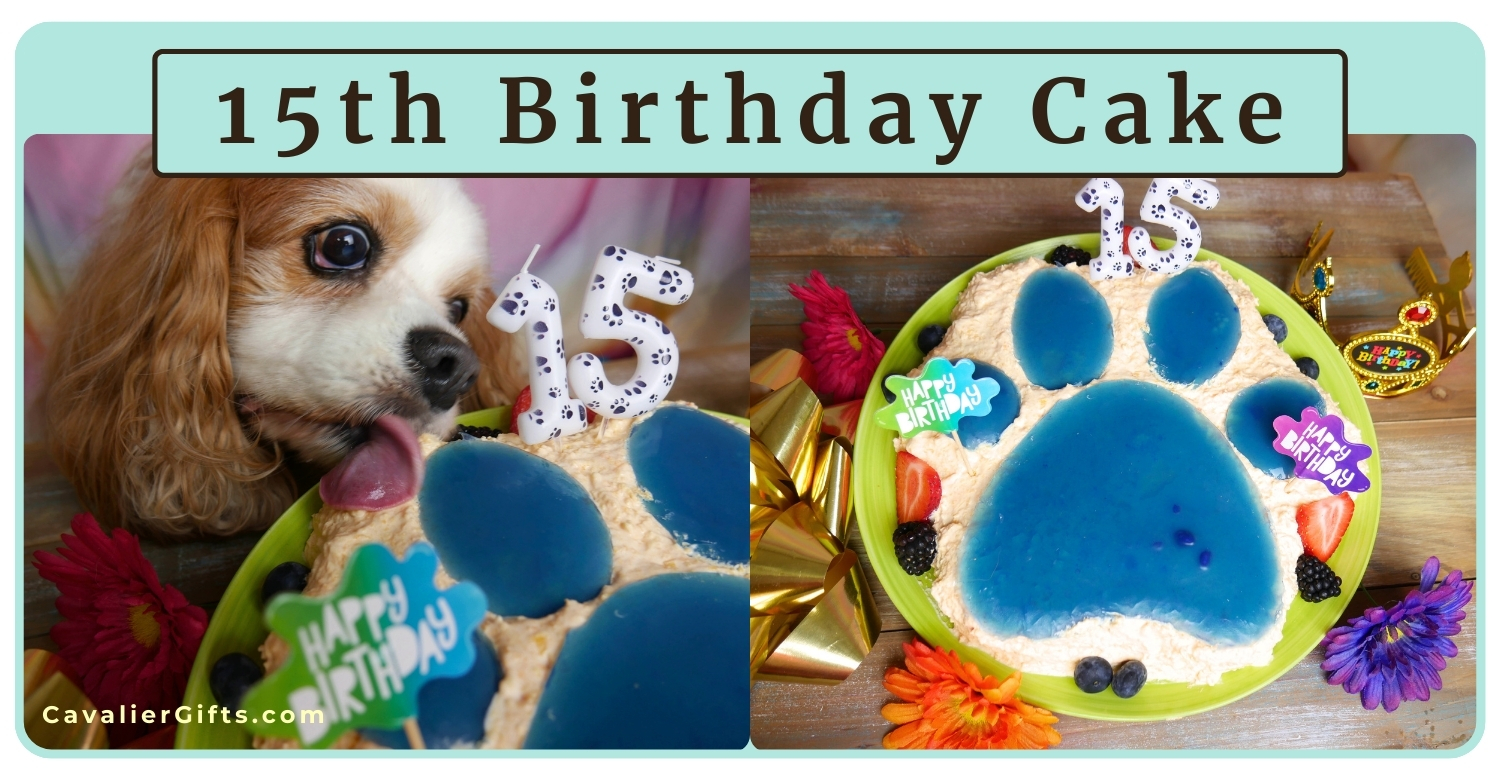

Celebrating Dexter’s 15th Birthday: A Cavalier’s Life Full of Love and Adventure (Early access for our Patreon community)
How to Celebrate a Senior Dog’s Birthday and Healthy Dog Cake Recipe




It’s hard to believe that Dexter, my best friend and constant companion, is turning fifteen! I’m over the moon that I am able to celebrate this milestone with him. He may be slowing down a bit, but his spirit and spunk remains as bright as ever. As Dexter has aged, we may have tweaked what we can do, but one thing has stayed the same: we live each day to the fullest, cherishing every moment.
Over the past couple of years, I’ve seen subtle changes in Dexter’s energy and behavior. He doesn’t have the boundless energy of his younger days, and he’s been going through some senior dog anxiety. We’ve learned to adjust our activities together, and I’ve been working on helping him feel more secure as his cognition changes. Our daily enrichment now includes slow, sniffy walks, leisurely poke arounds through the neighborhood followed by a stroll, and indoor adventures. He still enjoys simple training sessions, which keep his mind sharp, and I continue his canine fitness exercises to maintain his mobility and strength.
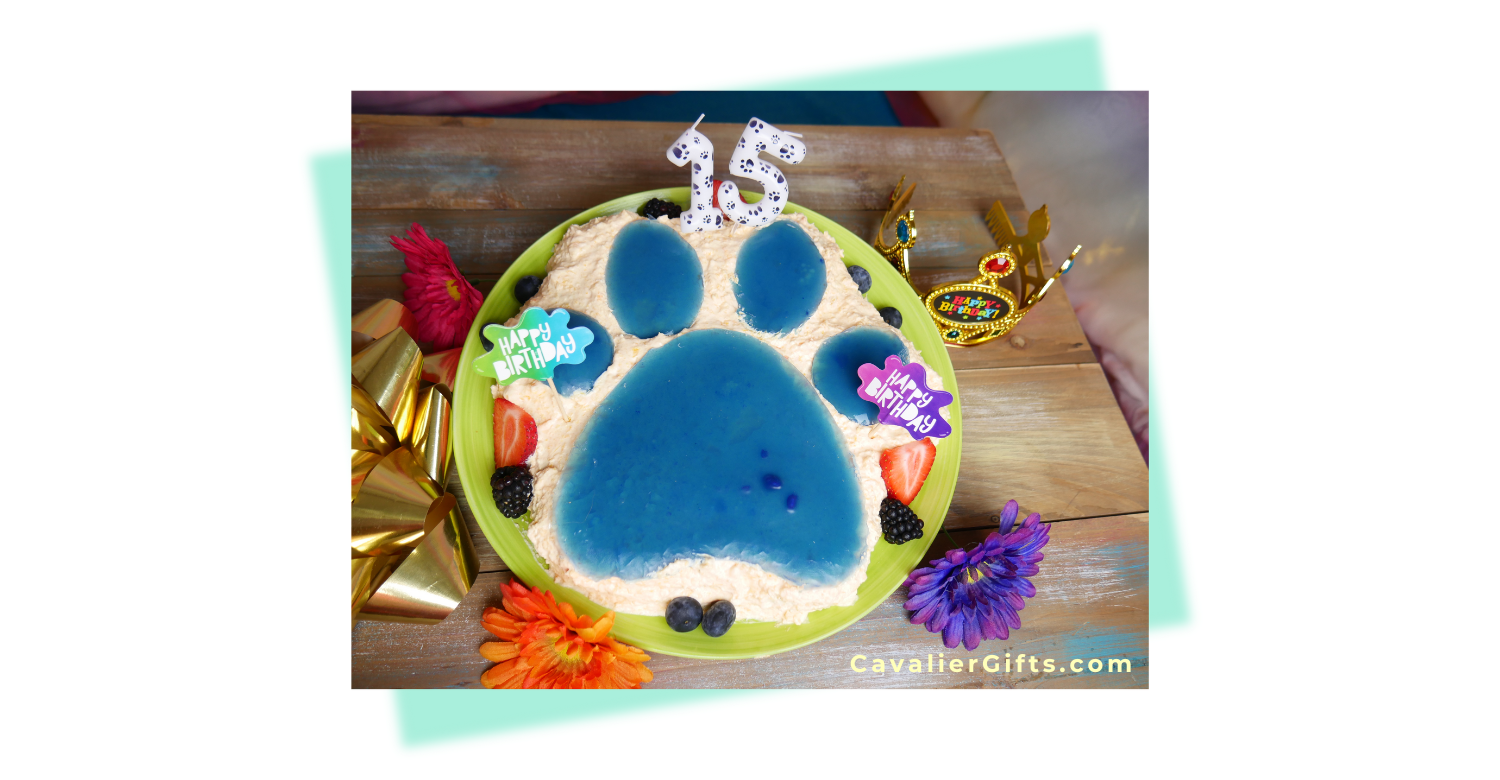

Earlier this year, Dexter went down in his back end after a reaction to medication. It was a scary time, and I wasn’t sure what his recovery would look like. I was actually wondering if his time was coming to an end. But after three to four months of dedicated rehab, I’m thrilled to share that he’s made a full recovery! Dexter’s resilience has always inspired me, and this experience only deepened my love for him. His ability to bounce back, even at fourteen, is a testament to his incredible spirit.
With Dexter by my side, I’ve been inspired to dive into new creative projects. Over the past year, we launched this blog dedicated to Cavalier King Charles Spaniels. This is actually our second blog! Check out our first blog, Raising Your Pets Naturally. I’ve also created a children’s coloring book, Dexter’s Adventures, bringing his playful and inspiring spirit to life for a younger audience. Which makes this his 3rd children’s book! Everything I do is shaped by Dexter, and I’m so lucky for the joy and inspiration he brings.


Our mantra has always been to live each day to the fullest, and as Dexter turns fifteen, this really hits home. Every day is a gift, and I’m beyond thrilled to have Dexter with me on this journey. Together, we continue to embrace life, even as we both slow down, finding joy in the simple moments we share.


Celebrating Dexter’s birthday is more than just a tradition, it’s a reminder of the love, laughter, and resilience we’ve shared throughout his life. During Dexter’s birthday celebrations, we always make sure to support Cavalier Rescue USA, a cause that’s close to our hearts. If you’re able to donate or volunteer your time, please consider checking them out, and be sure to tell them Dexter sent you!
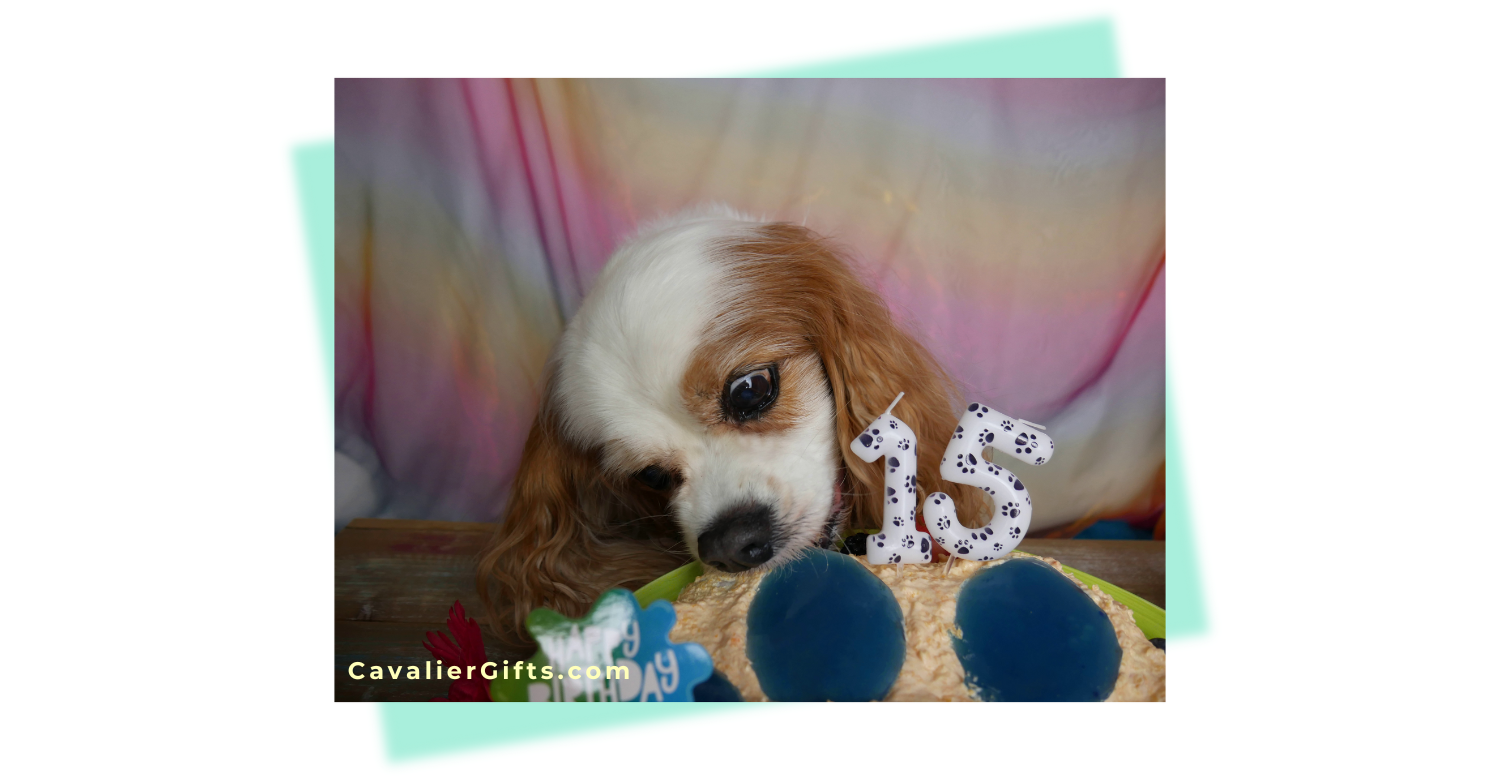

Here’s to Dexter, my silly monkey, stink pot, my muse, and the one who makes every day brighter with his love.
Don’t forget to subscribe to our @CavalierTipsandFun YouTube channel for more!


Dog-Friendly Strawberry Birthday Cake
Ingredients
Optional Blue Spirulina Gummy Paw Print Decoration
- 6 tbsp Beef Gelatin
- 2 tsp Blue Spirulina
- 2 cups Boiling Water
Strawberry Dog Friendly Cake
- 4 cups Quinoa Flour
- 6 Eggs
- 16 oz Strawberries Stems Removed
- 1/4 cup Olive Oil
Optional Dog Frosting
- 8 oz Cream Cheese check the ingredients to ensure it’s dog-friendly
- 10 oz Butternut Squash Cooked
Instructions
Blue Spirulina Gummy Paw Print Decoration
- In a large mixing cup, combine the gelatin and blue spirulina.
- Quickly stir in the boiling water until fully dissolved.
- Pour the mixture into the paw print cutouts in the paw-shaped cake pan. Pour any extra in other fun silicone molds.
- Refrigerate until set then gently remove the paw gelatin shapes.
- Place the paw shapes on a cookie sheet and return to the refrigerator while preparing the cake.
Dog-Friendly Strawberry Cake
- Preheat the oven to 350°F.
- Purée the strawberries in a blender until smooth.
- In a large mixing bowl, combine the quinoa flour, eggs, olive oil, and strawberry purée.
- Generously grease the paw print cake pan with olive oil.
- Pour the cake batter into the pan and bake for approximately 50 minutes, or until set.
- Allow the cake to cool for 15 minutes, then carefully remove it from the pan and place it on a cooling rack to cool completely.
Optional Dog Frosting
- Purée the cooked butternut squash in a blender.
- Add the cream cheese to the purée and blend until smooth and well combined.
- Once the cake is completely cool, frost the cake with the butternut squash and cream cheese mixture.
- Top with the blue spirulina gummy paw print decorations for a fun and colorful touch!
Join our vibrant Cavalier King Charles Spaniel community on Facebook, support our dedication to pet wellness on Patreon, and stay updated with our weekly newsletter for invaluable tips and insights into raising happy, healthy pets. Together, let’s make a difference in our dogs’ lives!
|
|
      
|
      
|
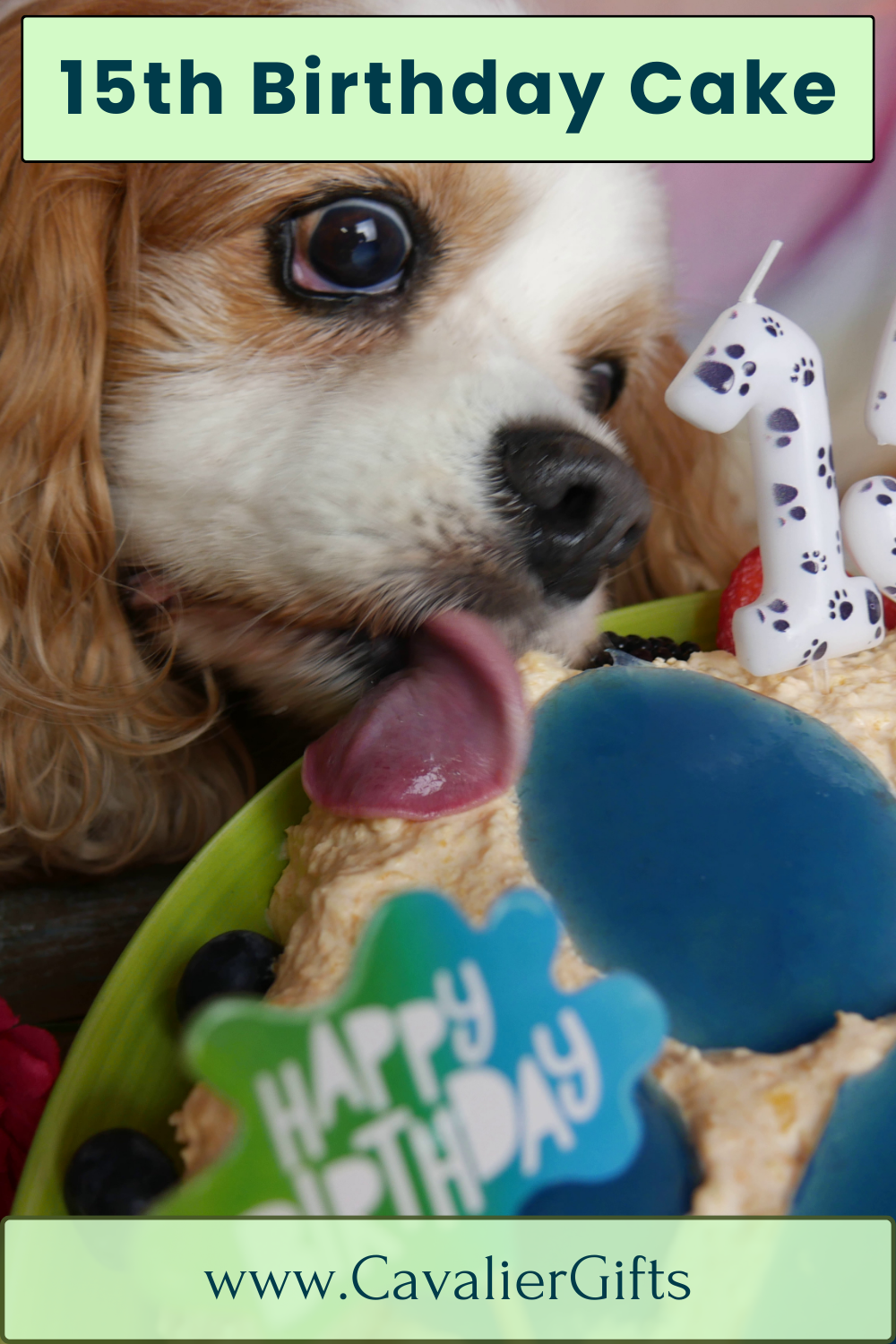

Google Ad Below
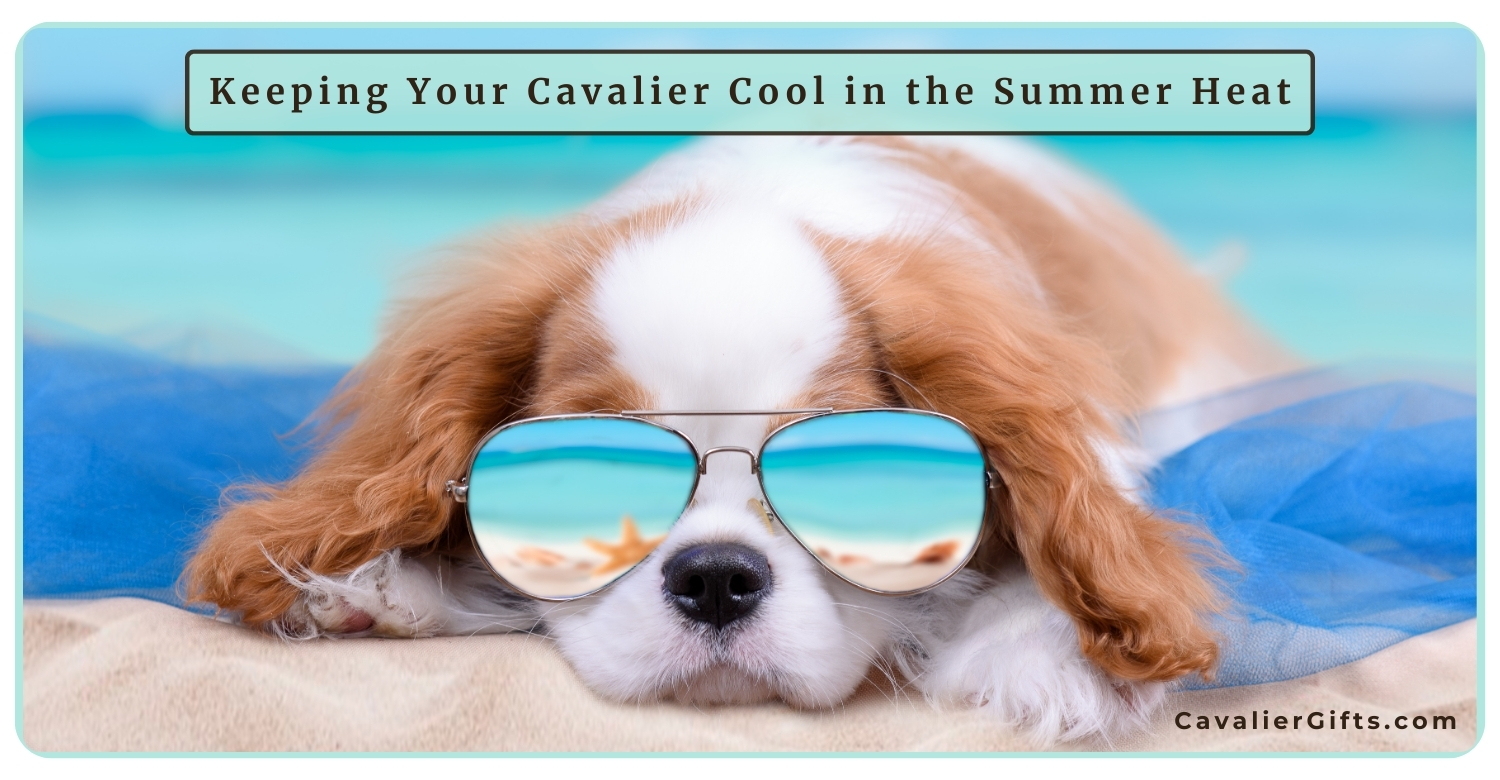

Keeping Your Cavalier King Charles Spaniel Cool and Safe in the Summer Heat (Early access for our Patreon community)
Hot Weather Tips for Cavalier King Charles Spaniels








He’s always run a bit hot, but now, as a senior and with MVD, the summer heat is just not ideal for him. But, it’s not just Dexter. Summer heat can pose health issues such as sunburn and heatstroke. Today, I’m going to jump into some ideas on how to keep your Cavalier King Charles Spaniel cool and active during the summer or warm months.
Cavalier King Charles Spaniels and Heat Stroke
Heatstroke is a serious concern for all dog families, particularly for breeds like the Cavalier King Charles Spaniel, which can be more susceptible due to their flat-faced (brachycephalic) nature. Any dog, any breed, and any age can develop heat stroke, even on cool days! The VetCompassTM conducted a study in 2016 regarding the risk factors for heat-related illness (HRI):
- Breeds with the highest incidence of HRI included the Chow Chow, Bulldog, French Bulldog, Dogue de Bordeaux, Greyhound, Cavalier King Charles Spaniel, Pug, and the Golden Retriever.
- Dogs at or above the mean adult body weight for their breed/sex showed an increased risk of HRI compared to dogs below the mean body weight.
- Dogs over 12 years old had the greatest odds of HRI compared to dogs under 2 years old.
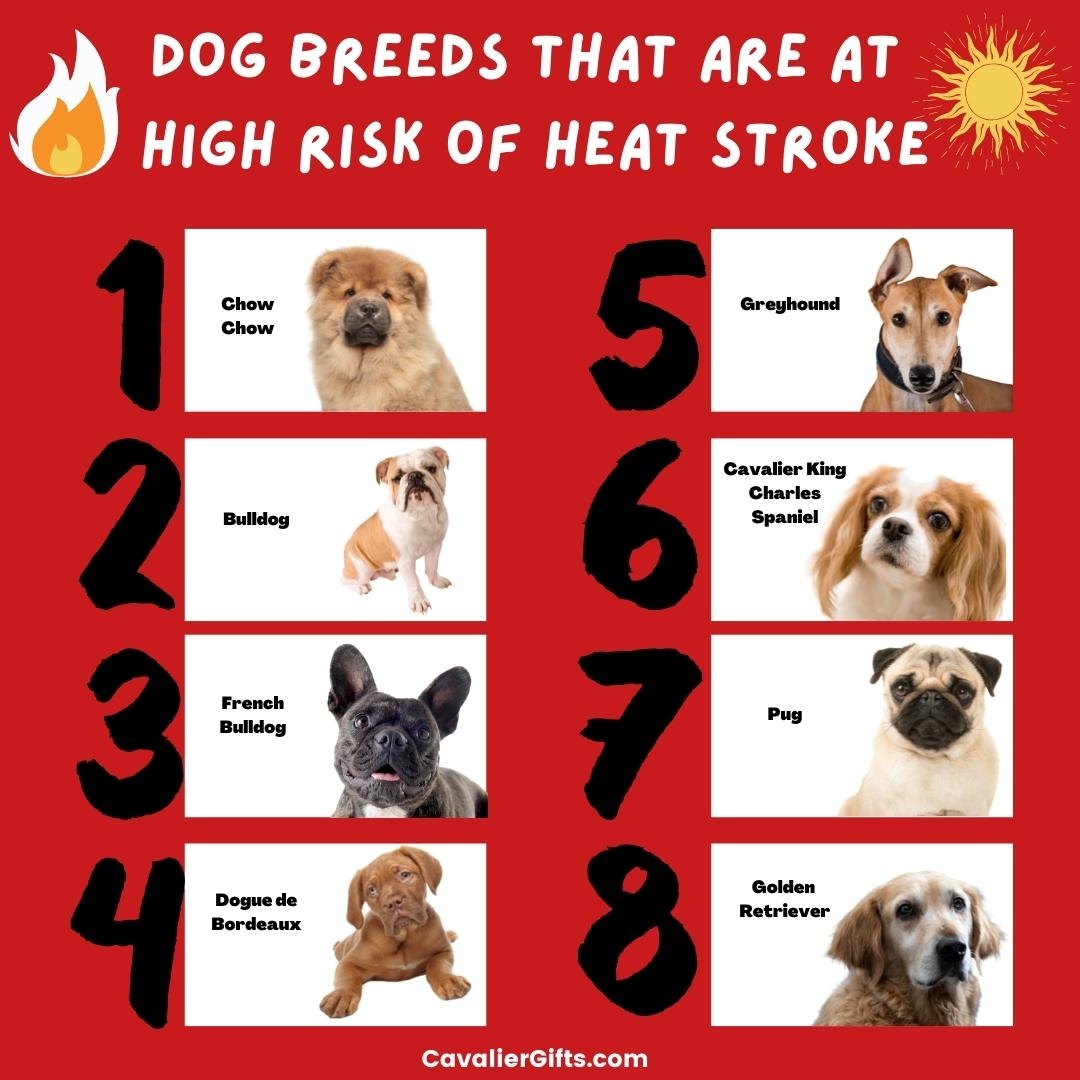

Signs of Heatstroke in a Cavalier
Recognizing the signs of heatstroke and taking preventive measures are crucial to keeping your dog safe. Signs such as excessive panting, drooling, rapid pulse, and restlessness indicate your Cavalier may be overheating. If you notice these symptoms, act quickly by providing cool (not cold) water and applying damp towels to areas with good blood flow, such as the head, armpits, and groin. Then take your Cavalier to the vet to prevent things from getting worse.
How Food Affects Your Cavalier’s Ability to Tolerate Heat
Just like for us, our pet’s food does more than just provide them with calories. Food has a big impact on their overall health, affecting everything from their longevity to their behavior and how they handle hot and cold temperatures. According to traditional Chinese medicine (TCM), everything in life has a balance of energy and heat, represented by Yin and Yang. Yin embodies the cool, and yang is the hot. This includes our pets, food, and environment; they all have specific energetics.
Dexter tends to run a little more yang (hot). Therefore, when I’m creating his meals, I aim to have the foods I provide either be energetically cooling or neutral. I avoid energetically warm or hot foods and proteins. For example, common foods that are warming or hot include goat, lamb, venison, chicken, and pheasant. Whereas, cooling proteins include rabbit, duck, beaver, cold water fish, and muskrat.
Applying this feeding concept to our Cavaliers, we can tailor their diets to help regulate their internal temperature. During the warmer months, opting for cooling foods can help maintain balance and comfort for your Cavalier.
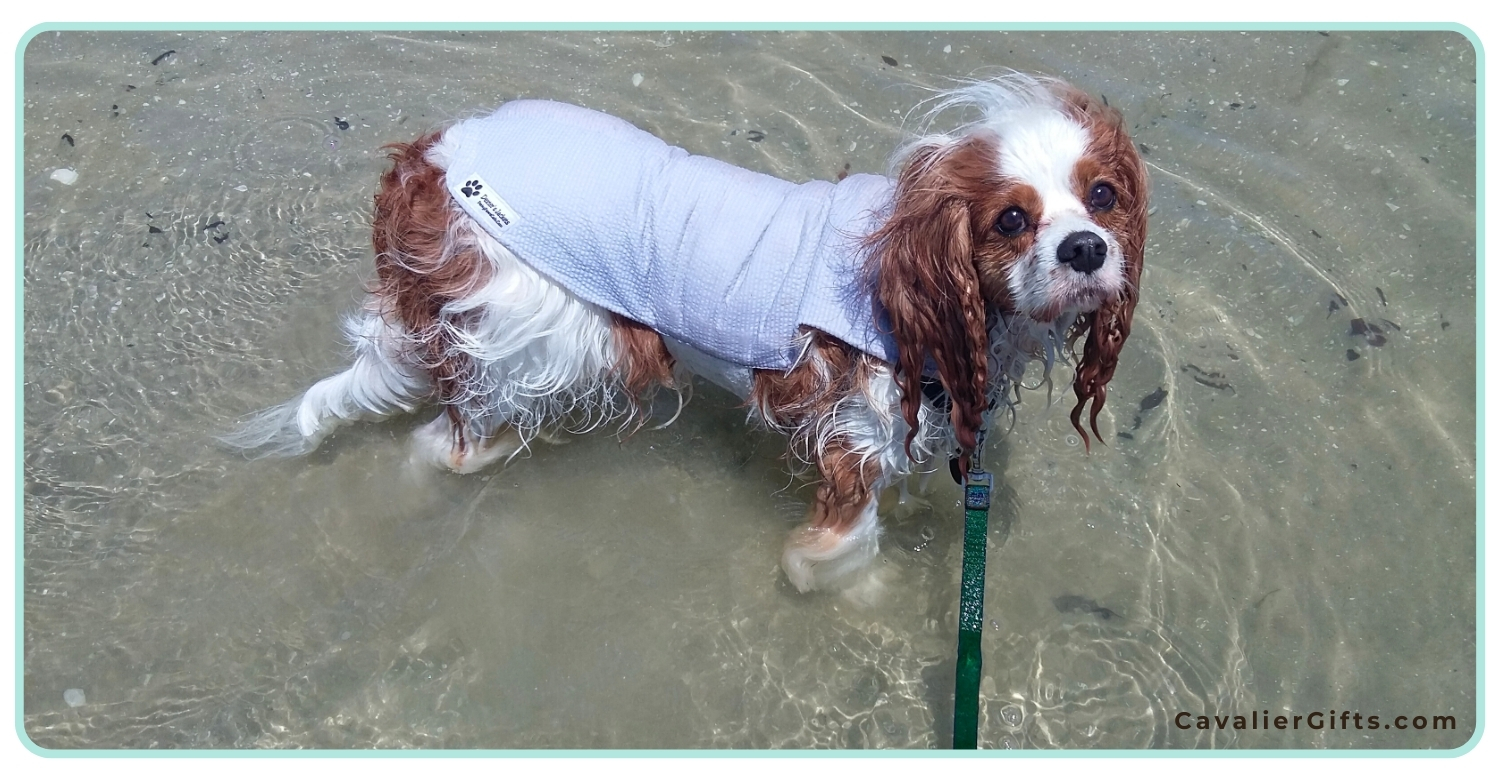

Google Ad Below
Summer Fun for You and Your Cavalier King Charles Spaniel
Despite the summer heat, Dexter and I still enjoy our summer adventures. They just need to be modified according to the weather. The first thing I do is check the weather, so I’m not out and about with Dexter and surprised! Walking or strolling Dexter in the morning is by far cooler than in the evening. I know people suggest evening walks, but, honestly, the heat from the pavement and the atmosphere seem hotter to me than in the morning. Your location may be different.
Try walking on grassy areas instead of pavement. Shady parks beat the noon sun. Breezy days while wading in the water are another fun way to help your Cavalier stay cool. However, if it’s still sunny or warm, cool water on their feet and a breeze are unlikely to cut it.
We do a lot of indoor adventures during the summer months. Pet stores, dog friendly stores and attractions are our go-tos. I also do a lot of indoor training sessions and enrichment activities to help keep Dexter engaged. The bottom line is that I don’t want to risk Dexter’s health. And I can say from experience, it’s not a good feeling. Back in 2018, I’m pretty sure Dexter almost had a heat stroke! We were in Florida in the spring, doing touristy things. I thought I was being careful, bringing Dexter inside the stores, indoor attractions, and a covered train tour, but he really wasn’t doing well. He started showing signs of heatstroke. We rushed him to the hotel and cooled him down. I was lucky. And I’m not sure what I would have done if I wasn’t so lucky.


Hot Weather Tips for a Cavalier King Charles Spaniel
- Grooming & Trimming: Regularly groom your Cavalier to remove loose fur and prevent overheating. I do give Dexter a puppy cut by trimming his belly, legs, and tail. I started this because of his CM/SM, but it also helps lighten his load and keeps him cooler.
- Travel Comfort: Ensure your Cavalier’s comfort during travel with a well-ventilated crate or car harness, and schedule frequent breaks for water and shade. I also use a cooling mat and fan blowing on Dexter.
- Sunscreen: Dog friendly sunscreen on your Cavalier’s nose helps protect him from harmful UV rays.
- Cooling Products: Invest in cooling accessories like a cooling vest, bandana, or mat to provide relief from the heat during outdoor adventures.
- Avoid the Hottest Part of the Day: Schedule outdoor activities during cooler times, such as early morning or late evening.
- Mind the Pavement: Hot asphalt can burn your Cavalier’s paw pads. Stick to grassy or shaded areas for walks.
- Hydration: Always have fresh water available, and encourage your Cavalier to drink frequently to stay hydrated. I put bone broth cubes in Dexter’s water bottle to encourage him to drink. If not, he will ignore the water.
- Indoor Play or Outings: On exceptionally hot days, opt for indoor activities like interactive games or training sessions to keep your Cavalier entertained while staying cool.
- Cooling Foods: Opt for cooling or neutral proteins in your Cavalier’s diet.
Remain vigilant, provide ample shade and hydration, and monitor your Cavalier for signs of overheating. Keep your Cavalier King Charles Spaniel’s well-being in mind, and use these practical tips to make sure you and your Cavalier have a safe and enjoyable summer.
Your comments and questions are always welcome below.
Join our vibrant Cavalier King Charles Spaniel community on Facebook, support our dedication to pet wellness on Patreon, and stay updated with our weekly newsletter for invaluable tips and insights into raising happy, healthy pets. Together, let’s make a difference in our dogs’ lives!


|
|
      
|
      
|
Google Ad Below
